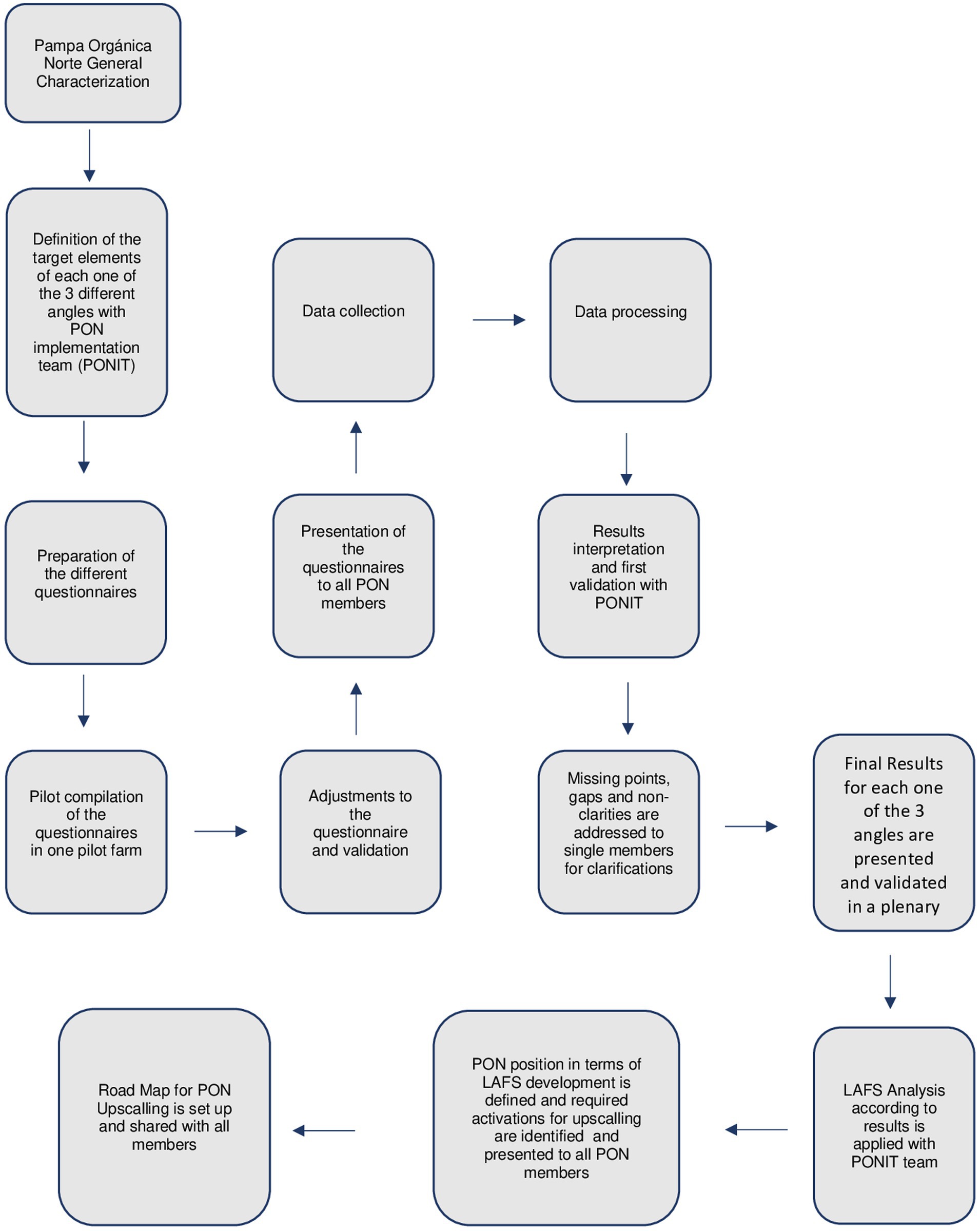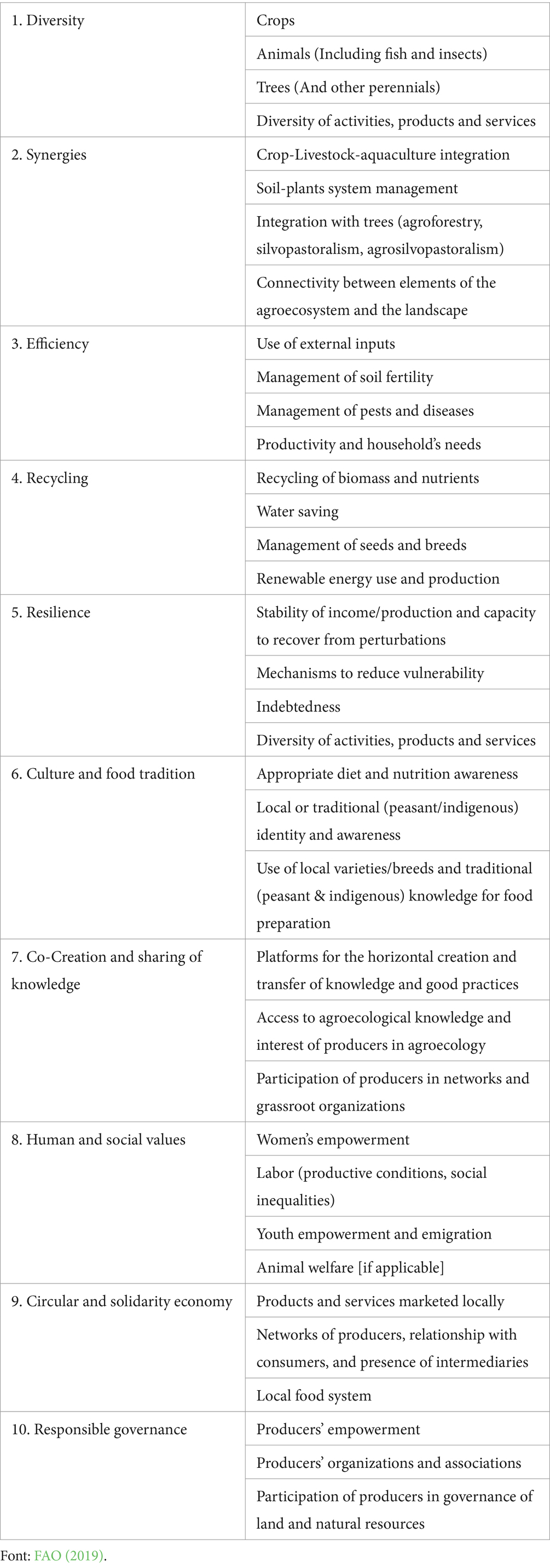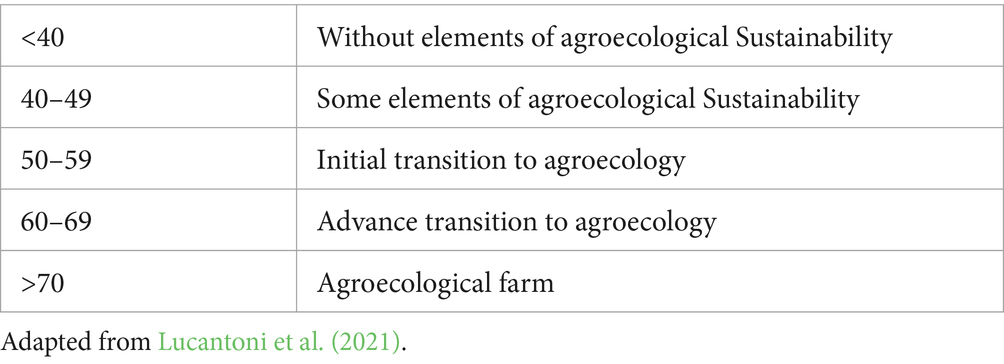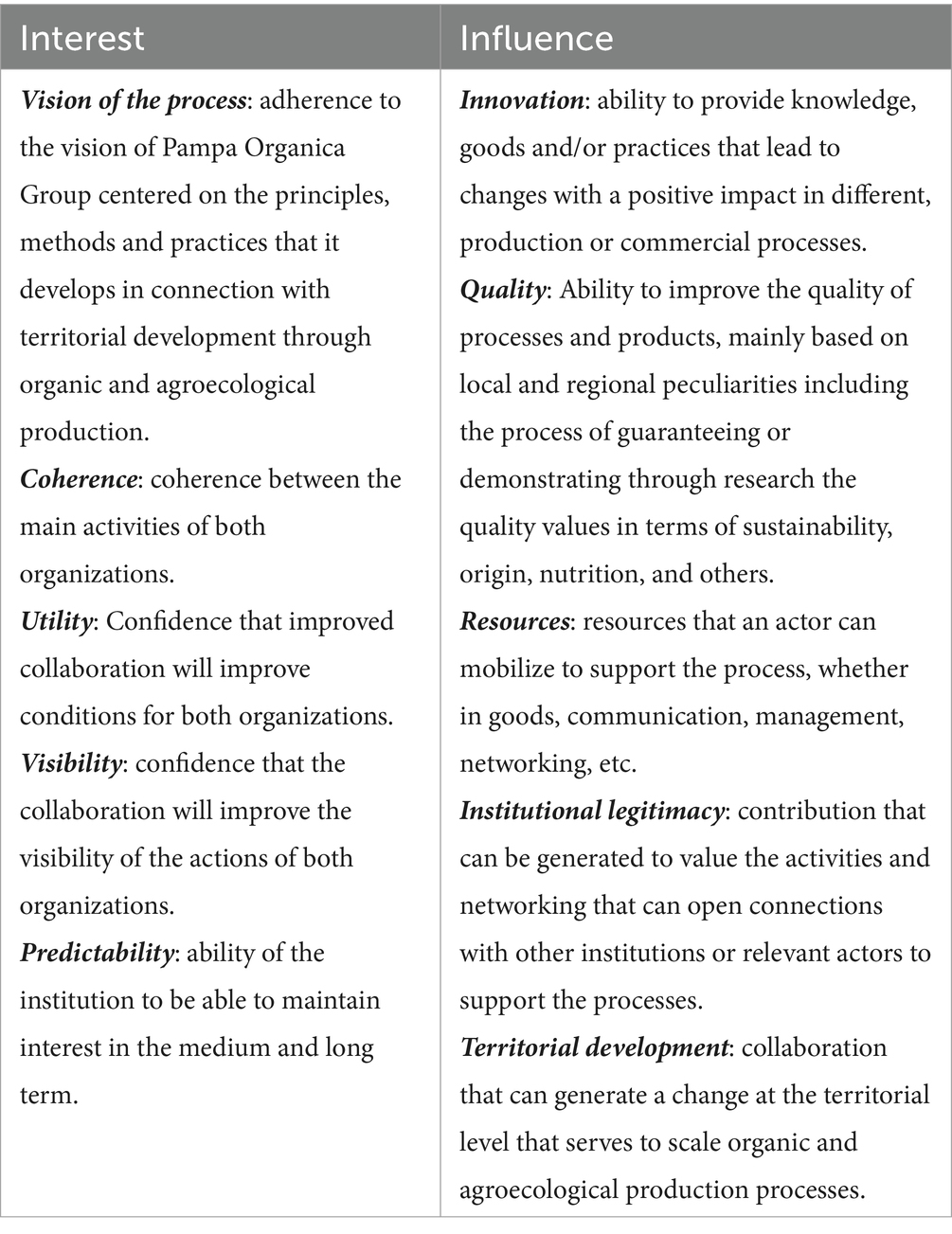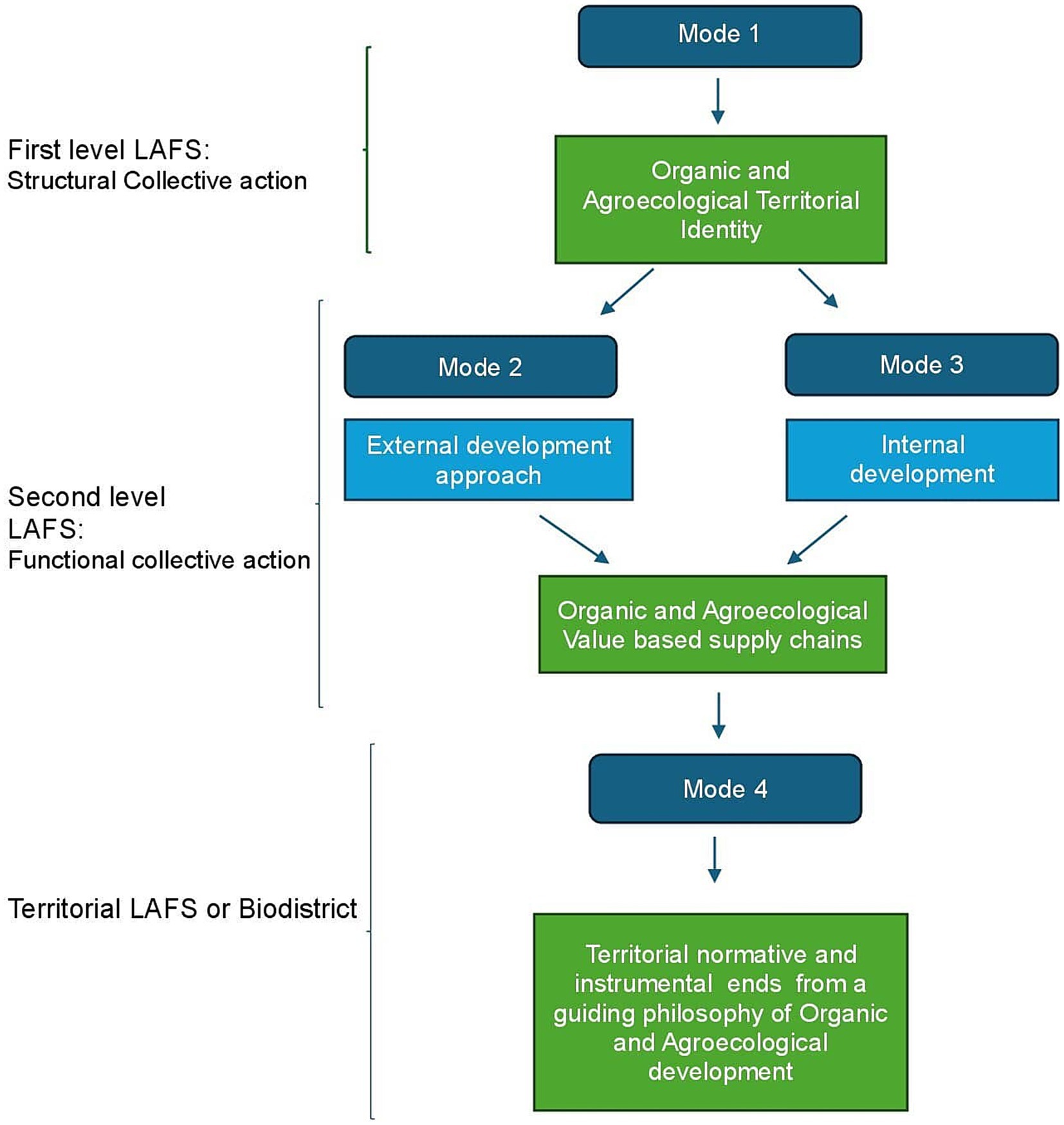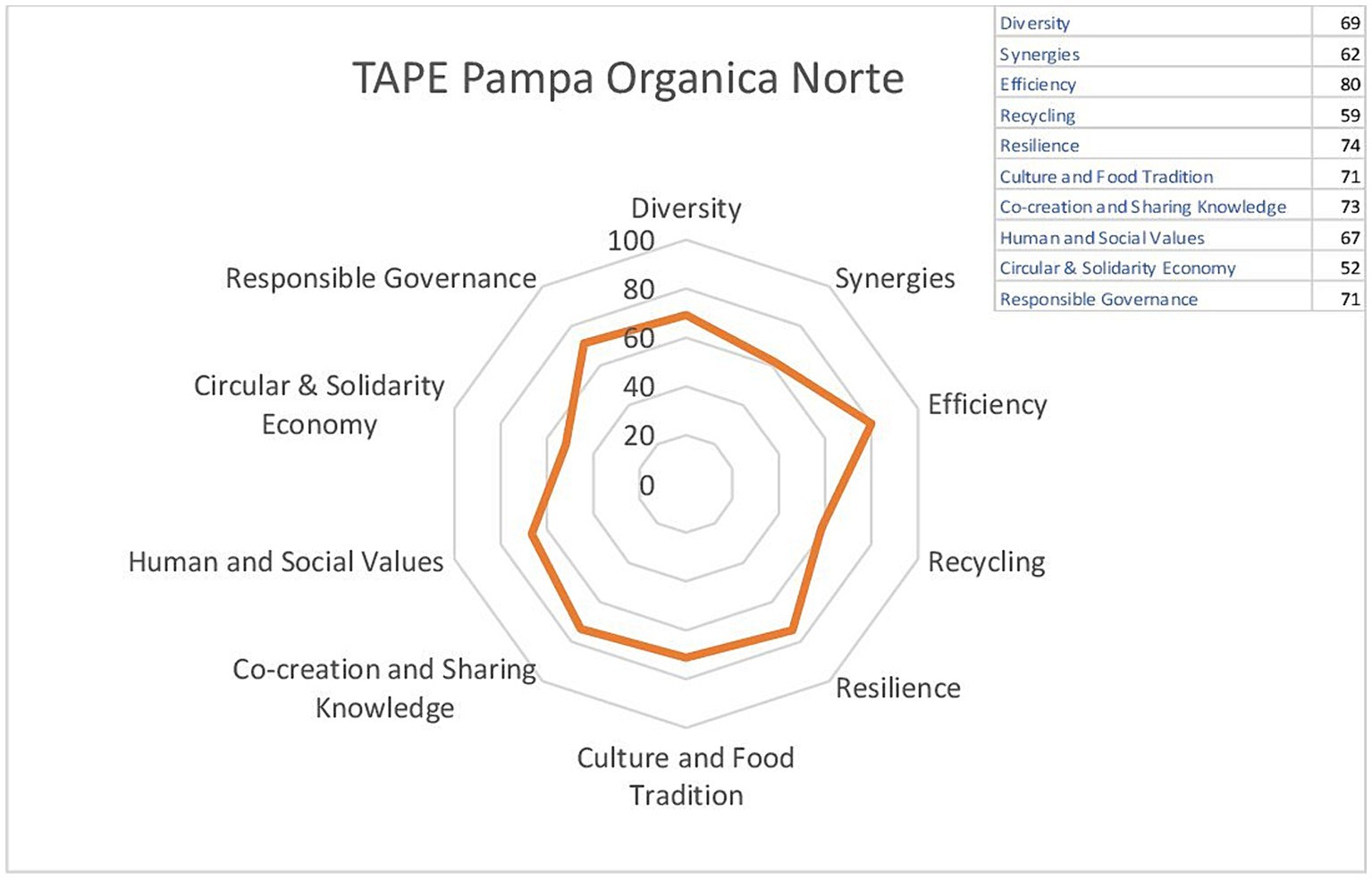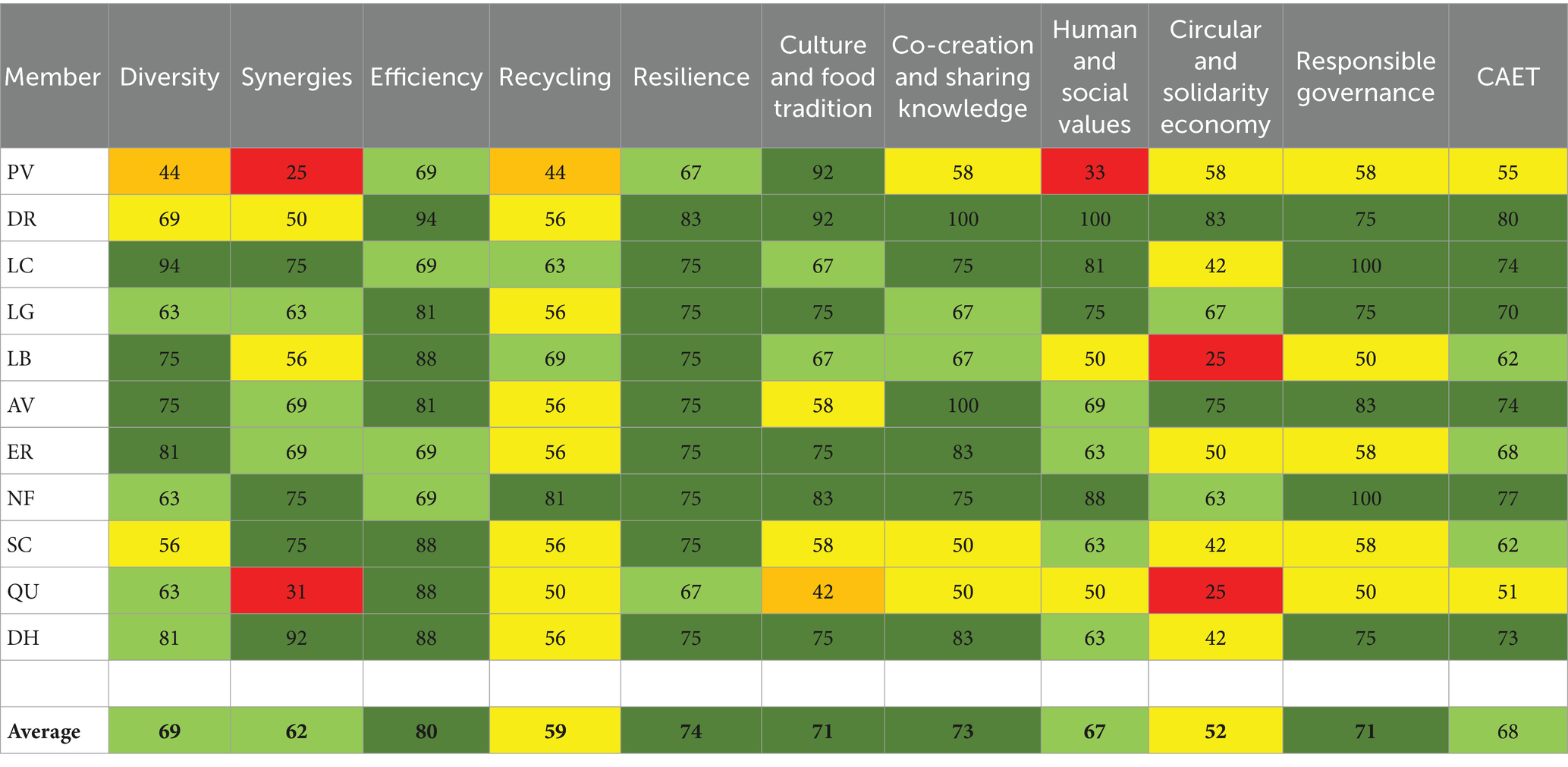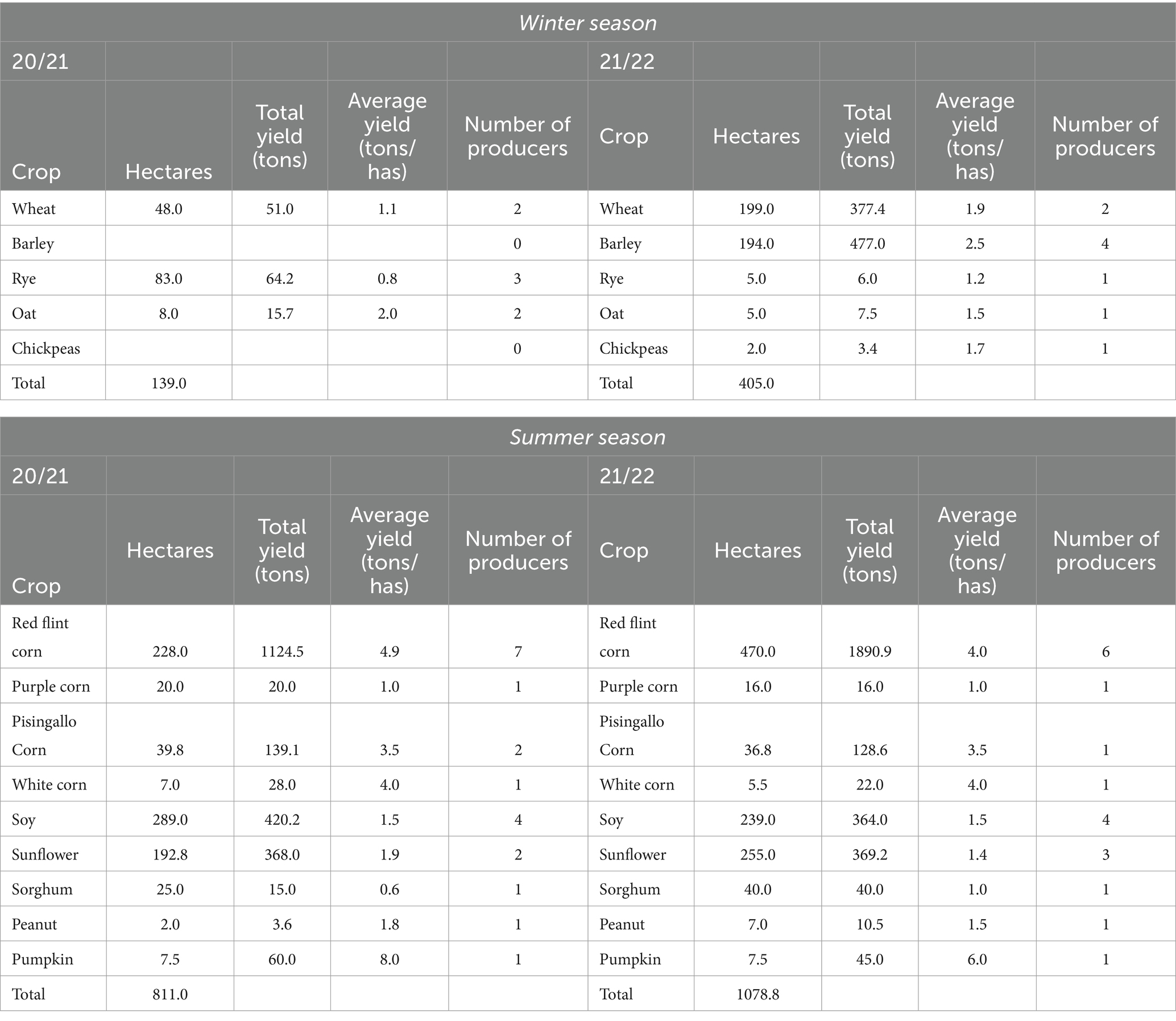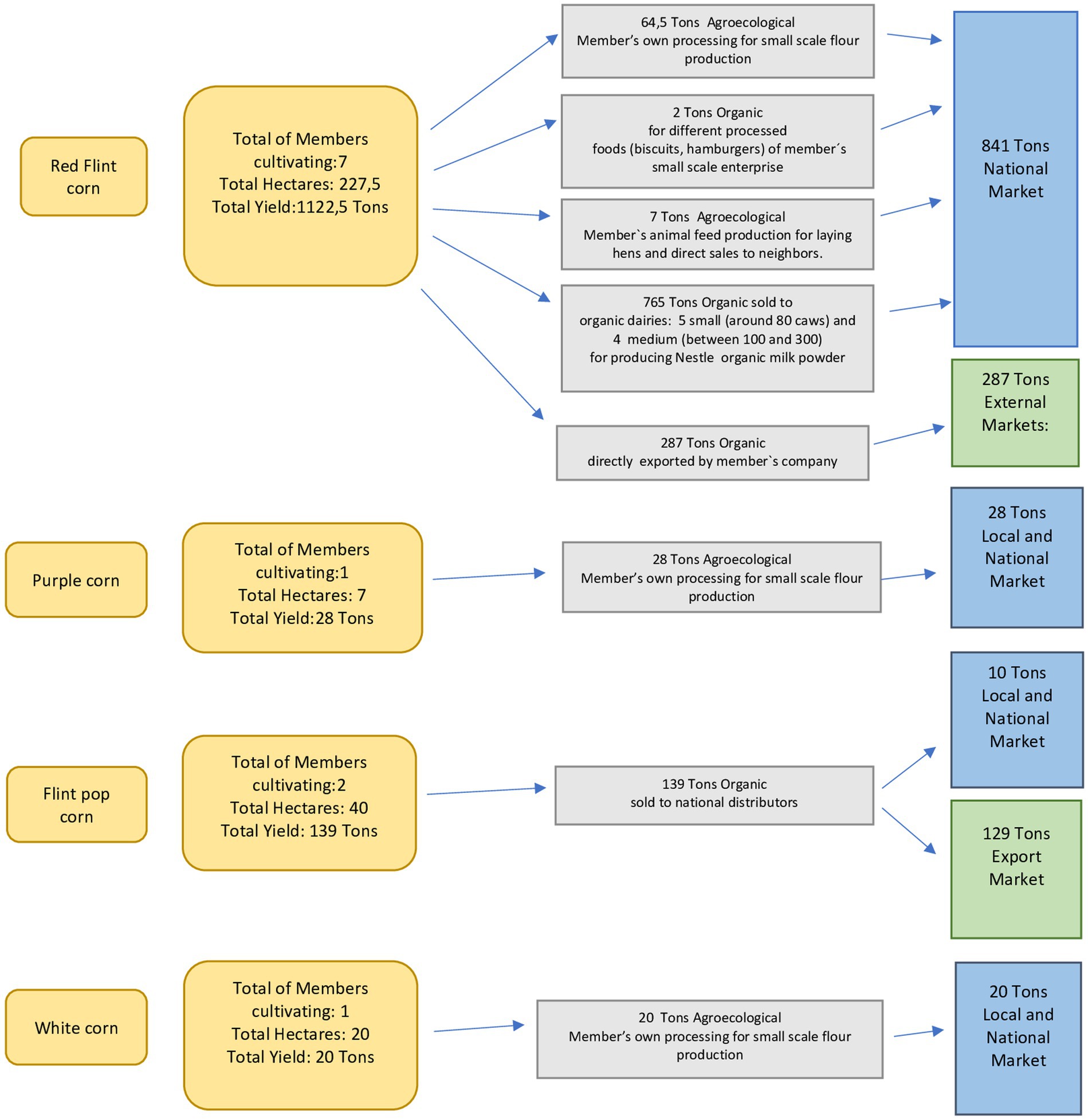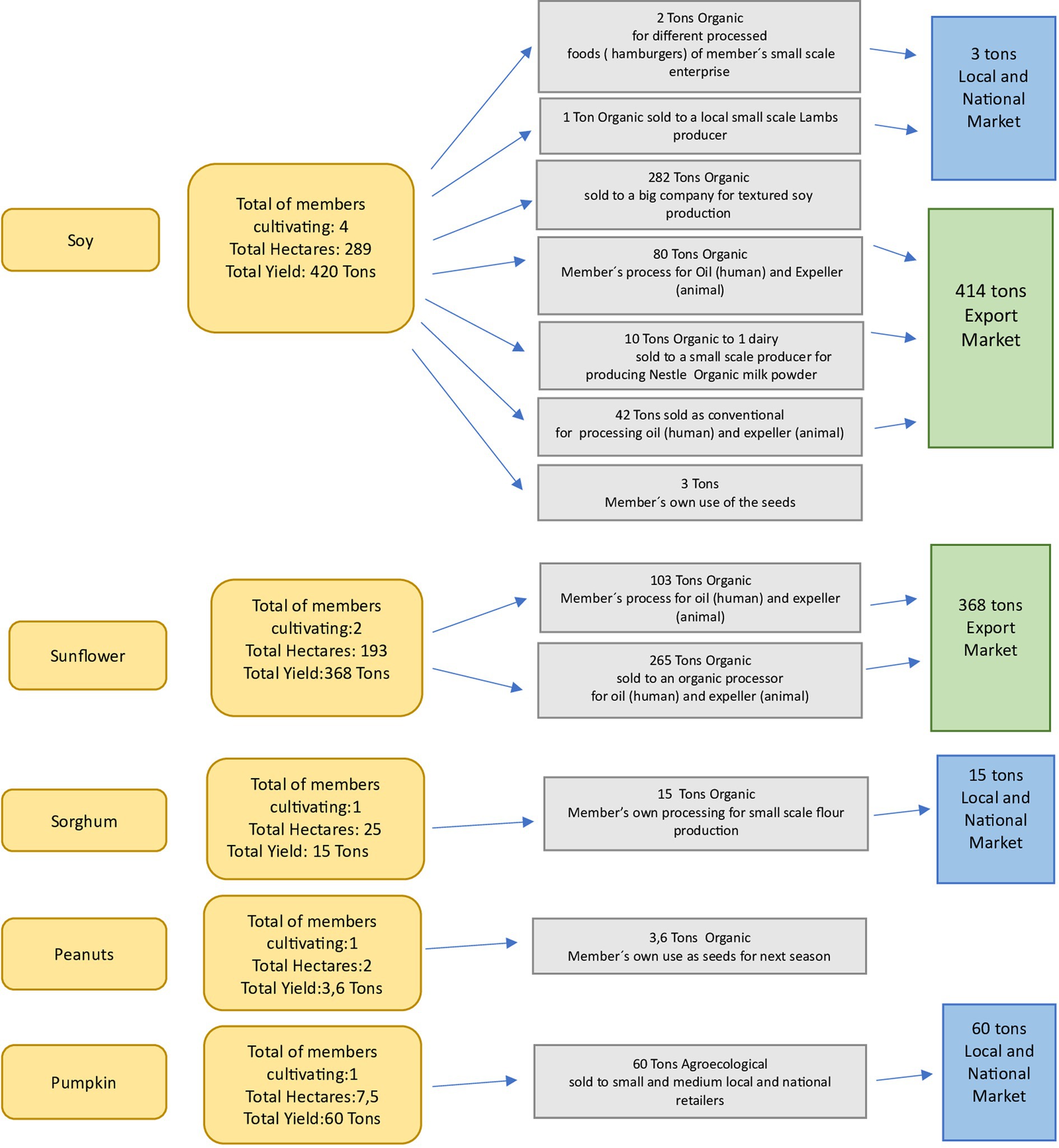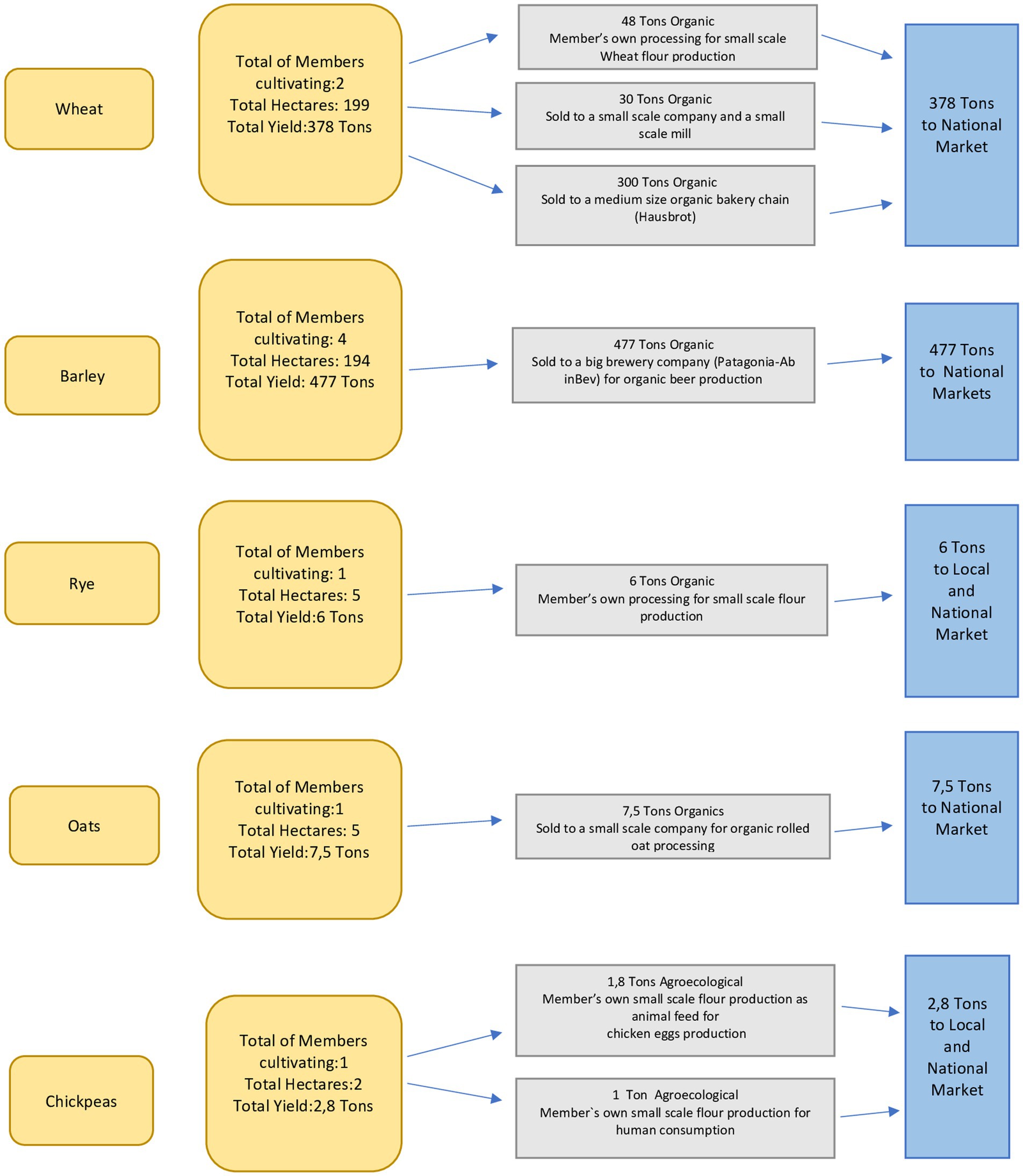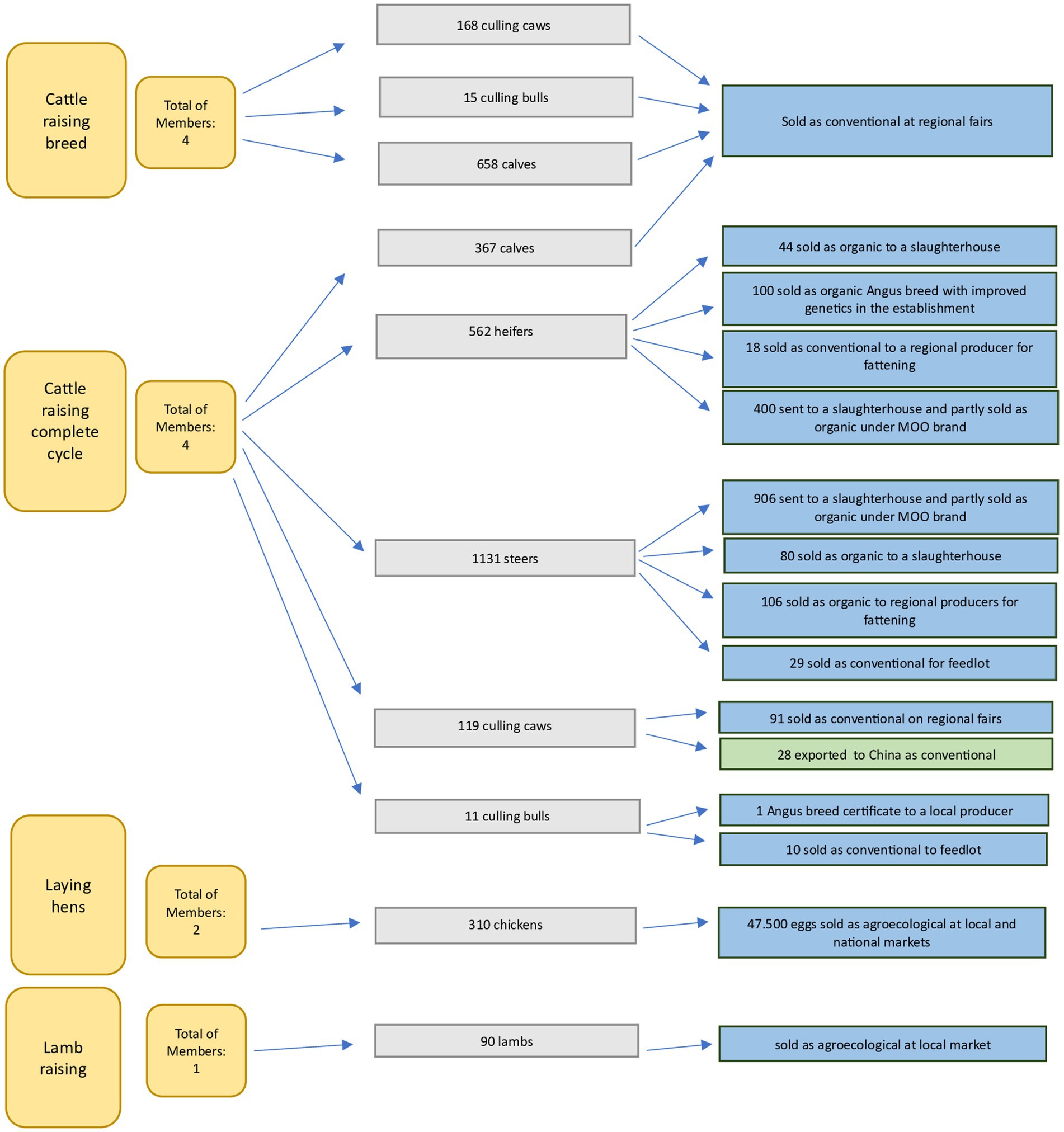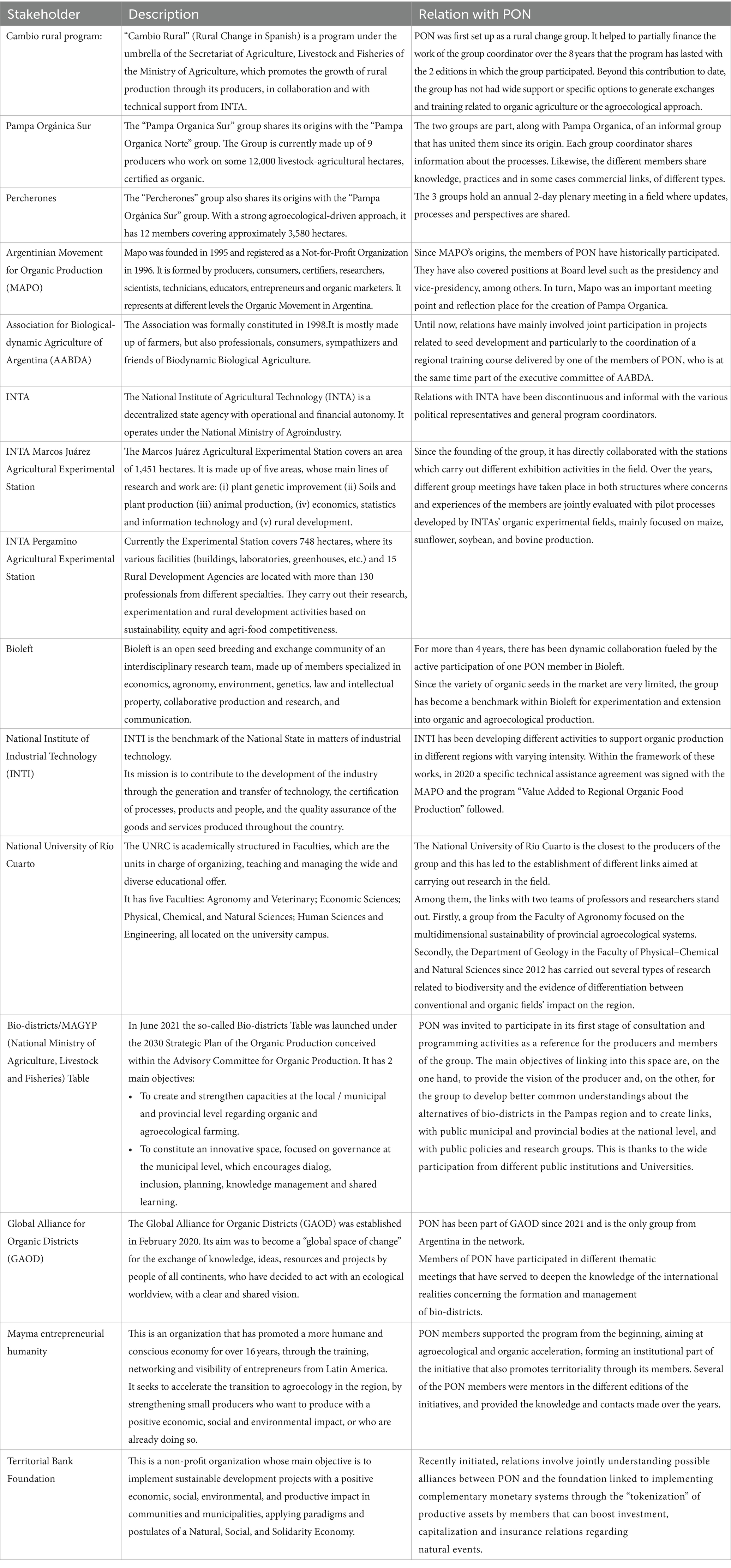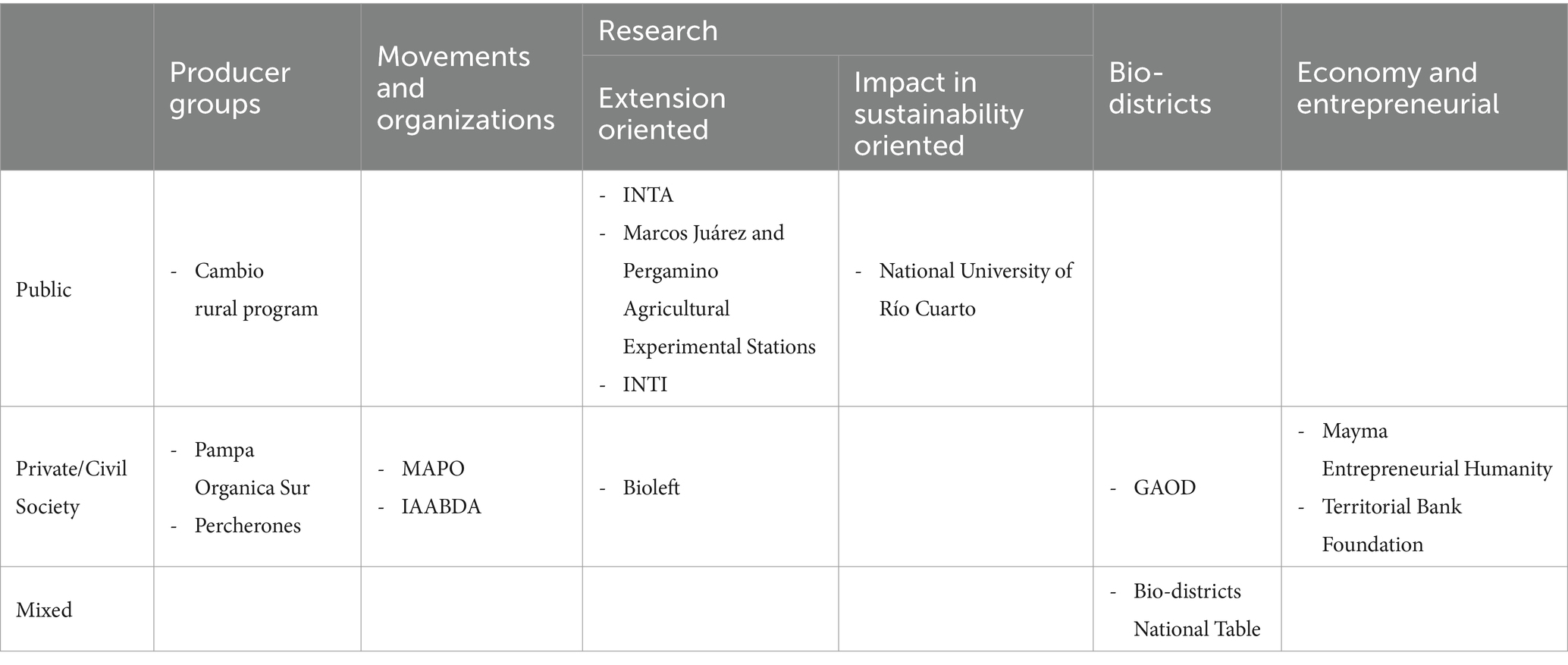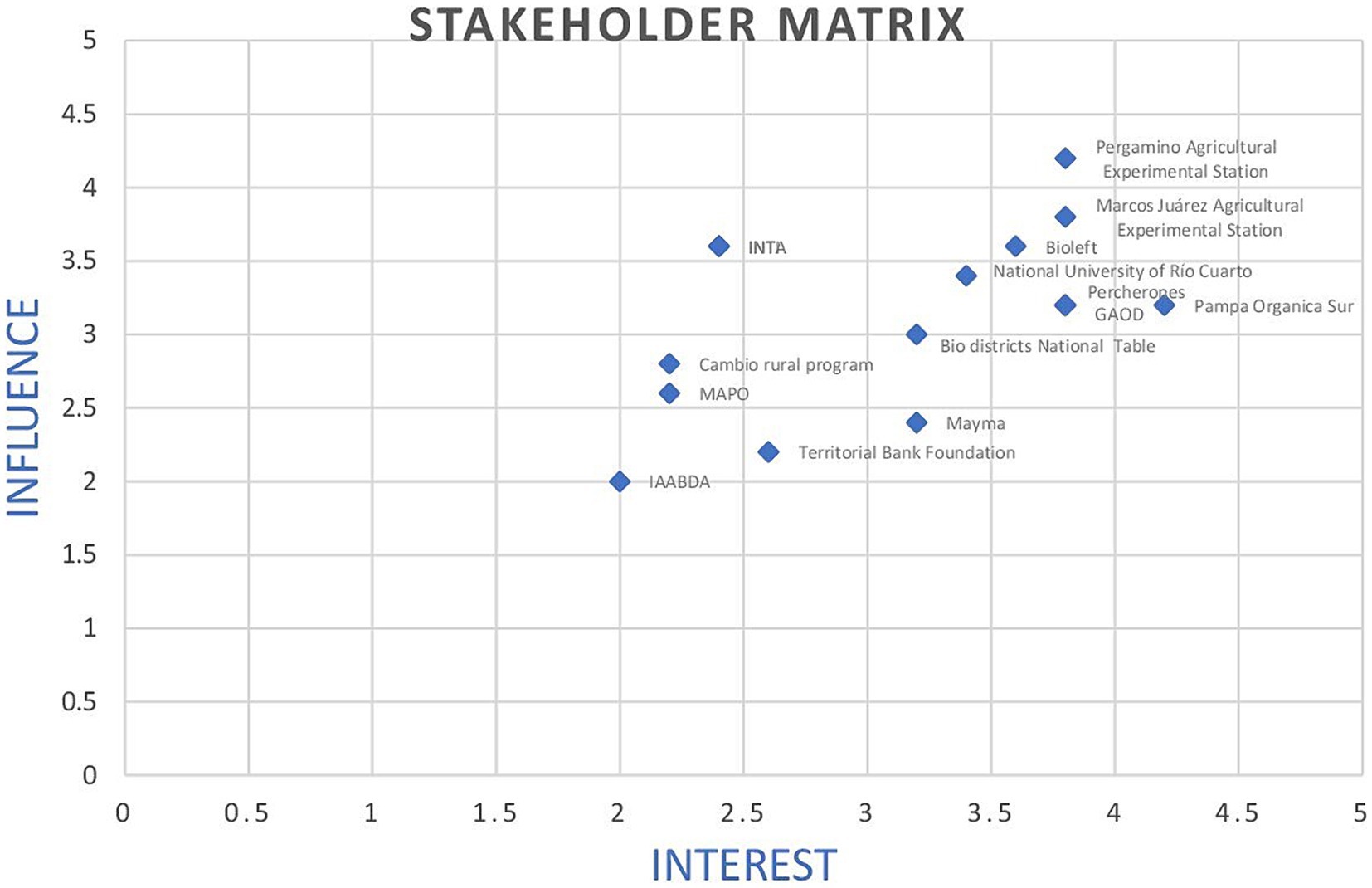- 1Department of Management and Economic Science, University of Parma, Parma, Italy
- 2School of Agriculture of the University of Buenos Aires, Buenos Aires, Argentina
Organic Agriculture and Agroecology are production systems considered relevant for building up sustainable food systems at an environmental, social and economic level. In recent years there has been a growing interest in considering which processes can contribute to upscaling these systems. At a global level Agroecological Local Agri-food Systems and Bio-districts are becoming beacons for that purpose. This paper presents a case study of an organic and agroecological group of producers in the Argentinian Pampa Region where we used the Participatory Action Research (PAR) approach in implementing three interconnected methodologies: (i) Sustainability assessment using the FAO Tool for Agroecology Performance Evaluation (TAPE), (ii) Participatory Value chain Development and (iii) Stakeholder Analysis. This was done to verify if the combination of methodologies can be useful to (i) evaluate the current situation of the group in terms of LAFS development and (ii) identify which possible activities would be required for upscaling organic and agroecological practices at a regional level with a neo-endogenous approach. We conclude that the participative assessment implemented was useful to identify the group stage in terms of LAFS development and also to identify the activation requirements for upscaling the system at the same time that the participatory process addressed and organized a set of procedures in the hands of the group for implementing that process.
1 Introduction
According to different widely representative organizations, organic agriculture and agroecology can positively contribute to challenges related to the SDGs (De Schütter, 2011; Migliorini and Wezel, 2017; Arbenz, 2018; Eyhorn et al., 2019; Nicolétis et al., 2019).
Evidence comes from different angles of knowledge such as farm viability, income and productivity (Aubron et al., 2016; D'Annolfo et al., 2017; Van der Ploeg et al., 2019), crop protection and biodiversity (Hole et al., 2005; Rahmann, 2011; Niggli et al., 2016), ecosystem services (Palomo-Campesino et al., 2018), food security and nutrition (Reganold and Wachter, 2016; Kerr et al., 2021), among others.
The staggering of these practices is an issue that is currently being raised at a global level (Food I. P. E. S., 2018) linked to their transformative capabilities, in order to face the dysfunctionalities of the current global food system (Sarandón and y Flores, 2014). In this sense, methodologies linked to the Localized Agro-food System approaches (Guareschi et al., 2020; Gonzalez De Molina and Lopez-Garcia, 2021) are increasingly being experimented and considered as a possible strategy for addressing organic and agroecological upscaling challenges.
The concept of Localized Agri-Food Systems (LAFS) has its origin in economics theories that studied concentrations of companies linked to a territory, in particular Industrial Districts and Local Production Systems. The late 1990s saw the proposal of an alternative model for strengthening the Rural Agroindustry (AIR) as the main axis of a “new rurality.” LAFS experimental development process was oriented to the analysis of a variety of products and regions, especially from Latin America and Europe with the aim of generating new income and sources of employment in the most depressed areas, but also as a node of local development in a global environment (Boucher and Reyes Gonzalez, 2016).
The LAFS Approach incorporates features and elements from different disciplines. This involves dealing with human geography, technical knowledge, food modalities, management of common resources, governance, power relations, institutionalism, the industrial economy and the economy of proximity, collective action and social capital (Poméon et al., 2007).
It is important to emphasize the contributions of Lowe et al. (1995) with the Cultural Economy approach where the word “economy’” indicates the relationships between resources, production and consumption, while “culture” attempts to capture the reorganization of economies at the geographical scale from the local cultural identities and specific territorial characteristics and values. It influences LAFS with a “Neo Endogenous” approach by addressing a dynamic relationship and mutual recognition between two forces; the endogenous one, concerned in production mechanisms centered in the local culture and the pursuit of the interests of the territory and it local needs, and the exogenous one centered on the “external consumers” to whom the territory seeks to sell.
Bio-districts and Agroecology-based Local Agri-food Systems (ALAS) are built on this relation between internal and external forces harmonizing different needs with a strong focus on economic, environmental and sociocultural sustainability (Zanasi, 2020; Gonzalez De Molina and Lopez-Garcia, 2021).
Different experiences around the world have added value and expertise to the approach, facilitating the establishment of the International Network of Ecoregions (IN.N.E.R.) in 2014, followed by the development of the Global Alliance of Organic Districts (GAOD) in 2020.
The Participatory Action Research approach (PAR), closely linked to and influenced by Freire’s (1969) pedagogy in Latin America have been adopted by Agroecological movements throughout the world due to it upscaling processes (López-García and González de Molina, 2021). Its roots in the social sciences are based on considering the integration of researched actors as protagonists in the investigative processes (Guzmán et al., 2013).
The aim of this article is to consider if PAR methodology, linked to the Tool for Agroecology Performance Evaluation (TAPE), the participatory elaboration of group value chains and stakeholder analysis are suitable to: (1) Identify the current stage of LAFSs; and (2) identify the possible actions that can shape a road map for upscaling them. The analysis is referred to the Pampa Organica Norte Group, which represents a particular Organic and Agroecological LAFS because of its socio economic and environmental characteristics.
1.1 Argentinian Pampa region and PON characterization
Pampa Region extends over an area of 540,000 km2 comprising almost the entire province of Buenos Aires and part of the provinces of La Pampa, San Luis, Córdoba, Santa Fe and Entre Ríos (Burkart et al., 1999). It is the heart of the Argentinian grain production, representing 5% of the world’s total (INDEC, 2021).
The production system broadly implemented in the area is a consequence of the late massive implementation of the Green Revolution practices, strongly influenced by the introduction of genetically modified soybeans (RR-soy) resistant to glyphosate in 1996/97 (Aizen et al., 2009; Pognante et al., 2011). It displaced traditional livestock production to areas less suitable for agriculture (Rearte, 2003; Guibert et al., 2011) without taking into account the true cost of these practices with their environmental and social externalities (Tittonell et al., 2020).
Unsustainable consequences have been widely documented, such as loss, degradation and compaction of soils (Casas, 2006; Casagrande et al., 2009; Tsiafouli et al., 2015), loss of meso and macro fauna and arthropod species, which provide biological pest control or pollination services (Dainese et al., 2019; Martin et al., 2019), contamination (e.g., eutrophication) of ground and surface water derived from the excessive use of agrochemicals (Viglizzo et al., 2006; Vera et al., 2010), together with the excessive incorporation of nutrients, mainly phosphorous and nitrogenous compounds, due to the high animal concentration of livestock production systems under feedlots (Rearte, 2003; Herrero and Gil, 2008).
Increase in fertilizer consumption, from 300 thousand tons in 1990 to 4.6 million tons in 2019 (CIAFA, 2019), has also generated a significant loss of biodiversity (Jergentz et al., 2004; Zaccagnini, 2005) and genotoxicity, teratogenicity and cell damage have been extensively identified in populations close to agricultural fumigation areas (Carrasco, 2010; Carrasco et al., 2012; López et al., 2012).
Social-wise, the “simplification” of new technologies and the resulting reduction in the workforce at the end of the 90s had already driven out around 100,000 producers, introducing a gradual rural depopulation (Morello et al., 2006; Moreno, 2017). This led to a continuous concentration of land, with a systematic decrease of smaller facilities (SAGPyA [Secretaría de Agricultura, Ganadería y Pesca], 2002; Gras and Hernandez, 2008; Gras, 2013).
These dysfunctionalities were already identified in the early ‘80s with the rise of different ecological movements that began to question the fundamental concepts and practices associated with the “green revolution” (Sarandón and Marasas, 2015). During that period, there were few productive experiences based on organic and agroecological farming, and neither were a consolidated domestic market nor export mechanisms or channels established. In 1995, there were just over 10,000 hectares certified for plant production and other 100,000 hectares for livestock (SENASA, 2007).
Faced with this situation, a group of producers who shared spaces as the Argentine Movement for Organic Production (MAPO) and in the incipient experimental stations developed by the National Institute of Agricultural Technology (INTA), started a process to establish a form of common space based on solidarity and mutual trust. This involved one side sharing knowledge, techniques, inputs and commercial activities, while the other set about breaking with the loneliness that being an organic producer entails, in particular for those working in the extensive, mixed agricultural - livestock activities of the Humid Pampa.
The mixed agricultural and livestock systems that characterized the Pampas region for decades and that are nowadays strongly affected by the dominant monocultural farming system, have a number of advantages at different levels. Extensive livestock grazing is a major determinant of local biodiversity and function of the ecosystem, increasing microbial activities and carbon storage (Oggioni et al., 2020). It promotes nutrient recycling within the farm, facilitates the rotation between annual crops and pastures over time and it reduces the need for transport and/or processing of bulky biomass, therefore offering more opportunities for ecosystem service provision at a landscape level (Tittonell et al., 2020).
Thus, Pampa Orgánica on June 11, 2004, became the first extensive organic “Cambio Rural” Group. This program forms the basis of the National Institute for Agrarian Technology (INTA) assistance and exchange system.
With 8 producers at its origin, the cardinal points were Bordenave Municipality in Southern Buenos Aires, Alejandro Roca in Northern Córdoba, and Agustoni in Western La Pampa. The greatest distances between members were almost 1,000 km. From 2015 on, for reasons of distance, the group decided to divide itself into 2 groups, calling themselves Pampa Orgánica “Norte” which is the central actor of present research, and Pampa Orgánica “Sur,” taking the center of the city of Buenos Aires as its cardinal point. This facilitated the processes of visits and monthly meetings. As of 2018, the southern group has been further divided into 2 groups: Pampa Organica Sur, and the “Percherones” group. They remain linked to each other and continue to hold regular face-to-face meetings after the annual plenary sessions.
The “Pampa Orgánica Norte” Group is currently made up of 11 farms of varying sizes from 15 to 4,000 hectares, covering a total of 8,673 hectares, distributed across three provinces, Córdoba, Santa Fe, and Buenos Aires. Eight members are under certified organic management, covering a total of 7,892 hectares. Two are currently being converted for a total of 724, and one without certification for a total of 15 hectares.
Regarding the production of the fields, there is one exclusively agricultural farm, one that is now preparing the land and the productivity organization, one dedicated exclusively to livestock, and eight of mixed agricultural livestock production.
The staging analysis process that will be carried out below becomes relevant considering the potential that the country has for growth in relation to the limited development at the territorial level of Organic and Agroecological initiatives.
According to the 2018 national census, Organic, Agroecological, and Biodynamic productions recorded a total of 5,253 agricultural units out of a total of 250,881 farms, representing only 2% of the facilities surveyed (INDEC, 2021). It is important to emphasize that the census reflects the perception of those interviewed concerning their agricultural practices, and does not refer to their participation in guarantee or certification systems that effectively certify their respective practices. At the moment, as regards the Agroecological level, this is the main information available, since no other type of statistical data has been generated so far from other side in terms of organic production, according to the National Agri-Food Health and Quality Service (SENASA, 2007) the total number of organic certified agricultural units in 2021 were only 1,336.
2 Materials and methods
Participatory Action Research approach (PAR) is used with the aim of developing a collaborative process where researchers and participants identify a situation in need of change and collectively develop a bottom-up co-designed set of methodologies in order to achieve specific goals (Méndez et al., 2017; López-García and González de Molina, 2021).
Core elements from the monitoring tool for Eco-Regions (Zanasi et al., 2020) are integrated at different levels, starting by identifying a representative group of the Pampa Organica Norte Group to actively participate in PAR processes to validate the relevance of the different approaches (Figure 1).
Research is implemented in two moments, a first where three interconnected methodologies are jointly addressed: (i) Sustainability assessment using the FAO Tool for Agroecology Performance Evaluation (TAPE), whose fundamental objective is to evaluate the practices that the group develops based on the FAO 10 elements of agroecology (ii) Participatory Value chain Development; where it seeks to understand and quantify the variety, modality and complementarity in production and (iii) Stakeholder Analysis; where the institutional relationships in which the group develops are identified and analyzed.
The results obtained from the joint implementation of these three methodologies constitute the inputs to generate the diagnosis based on LAFs methodological approach that serve first to evaluate the current situation of the group and secondly to identify which possible activities would be required for upscaling it stage and therefore organic and agroecological practices at a regional level.
2.1 Application of FAO tool for agroecology performance evaluation (TAPE)
The first process after the characterization of the group is the implementation of the Tool for Agroecology Performance Evaluation (FAO, 2019), which is an analytical framework that incorporates key attributes of several existing multidimensional assessment methodologies, developed by a panel of international experts. It uses agroecology to assess sustainability and to measure the multidimensional performance of agricultural systems at the household/farm level, but it also collects information and provides results at a community and territorial scale (Mottet et al., 2020).
The present methodological work is based on Step 1 of TAPE which is the Characterization of the Agroecological Transition (CAET). This is based on the 10 elements of agroecology (FAO, 2018) disaggregated into 36 indices, including the 13 principles of agroecology considering the multidimensionality of agricultural systems (Wezel et al., 2020).
For example, for the element of “Diversity,”indices are (i) diversity of crops, (ii) diversity of animals, (iii) diversity of trees, and (iv) diversity of activities, products and services (Table 1) scores of each ranges for 0 to 4 (a modified Likert-type scale), depending on how diversified crop production is. To obtain general score for the element “Diversity” the four indices are summed (e.g., 2 + 3 + 3 + 4 = 12) and the totals are standardized on a scale from 0 to 100% (12/16 = 75%) which is used to calculate the percentage and level of agroecological transition, called the CAET level (Mottet et al., 2020). First, the questionnaire was translated into Spanish (a translation was later available from FAO) and the questionnaire was programmed through the Kobotool box system according to the guidelines of the TAPE methodology (FAO, 2019).
To measure the characterization, we decided to adopt the scales proposed by Lucantoni et al. (2021) and Table 2 applying an average of the values obtained by the producers in order to facilitate the analysis of the results and their possible comparison with other groups. The objective of this survey was to put the general features of the different members on the same plane, and to be able to have a clear picture of the process of the group in general broken down into the different dimensions of sustainability proposed by the system.
2.2 Participatory value chain analysis
In order to carry out the value chain analysis, a participatory process was implemented with the group. The aim was to identify the key elements that could provide a complete picture of the group that would serve to highlight the existing productive diversity and the potential for external economies of scale, due to the presence of a critical mass of activities at the different links of the supply chain (Zanasi et al., 2020).
It was decided to approach the process through three different goals: (i) to identify main characteristics at a quantitative level of production, both at the agricultural and livestock level, (ii) to identify installed and available capacities in the different undertakings (in terms of cleaning, elaboration, storage and processing) and (iii) to identify market destinations of the different productions.
For the development of the questionnaire, different implementation modalities were evaluated, with the main objective of generating a tool that, on the one hand, would be consistent when including the aspects of the different productive, processing and distributive processes, and on the other, versatile enough to generate a process whose implementation could have continuity in time.
2.3 Stakeholder analysis
The complex and dynamic nature of food systems based on Agroecology and Organic Agriculture requires flexible decision-making that embraces diversity of knowledge and capabilities. Therefore, multi-stakeholder approaches have become an important instrument for analyzing specific contexts and designing effective interventions that match local needs (Guareschi et al., 2020).
SA can be seen as an approach that provides a series of guidelines and methods for analyzing and understanding social relations and mechanisms through the identification of the key actors involved in it, with their specific functions and interests (Grimble and Wellard, 1997; Reed, 2008).
In the same perspective developed for the realization of the TAPE and the Value Chain analysis, the methodological process of SA had the aim to empower stakeholders through the co-generation of knowledge (Greenwood et al., 1993; Wallerstein, 1999; Beierle, 2002).
Descriptive and normative approaches (Reed et al., 2009) were mainly used in this research-driven (Okali et al., 1994), people-centered (Michener, 1998) process. The methodological process is implemented following 2 steps: (i) identification, classification and description of the actors related to PON (ii) Stakeholder Analysis through an influence – interest matrix.
For the classification and description of the stakeholders, coordinating interviews were organized with the PONIT in a consultative way, in order to include in this phase: (i) the general characteristics of the organizations and (ii) the activities implemented or in the process of implementation with PON.
Taking into consideration the elements emerging from this process, we analyzed the stakeholders’ position and level of influence and interest using an I–I matrix and we converted this on a Likert scale from 0 to 5.
The identification and selection of the influence and interest indicators as presented in Table 3 were inspired on Porter’s (1998) dimensions and on researches that are ongoing for the evaluation and monitoring methods on Bio-district sector (Guareschi et al., 2020; Zanasi et al., 2020), adapted to the local conditions and group requirenments.
2.4 Organic and agroecological local agri-food systems models
Key element in the process of building the LAFS is the capacity of local actors to mobilize the passive advantages or externalities of agglomeration and/or latent solidarity, horizontally and vertically, toward a process of “activation” in a coordinated way that enhances the value of the specific resources of a given territory (Boucher, 2004; Boucher and Pomeon, 2010).
Following the approach already introduced, the results obtained under the three methodologies presented became inputs to analyze the current state of the PON group in terms of LAFS methodology and it the possible territorial activations.
Boucher (2004) distinguishes three important stages of LAFS: the first is based on a “structural collective action,” represented by the creation of a group such as an association, a cooperative or other form of organization where there are meetings and exchanges that favor collective learning. This first phase can be associated with the first operational mode proposed by Ray (1998): characterized by a commoditization of local/regional culture based on historical and/or environmental components.
The second LAFS stage is based on a “functional collective action,” by which institutions are generated and attached to rules that coordinate local actors around the management of the common good, according to the definition of quality parameters (criteria and indicators). In many cases, this second process of valorization and functionality is often related to what is considered Value based Supply Chains.
They are based on values beyond the economic value, which are shared by all partners along the chain. While some values are attached to the products and the mode of production, other values are inherent in the relationship between the partners involved (Marsden et al., 2000; Stevenson and Pirog, 2008).
This second stage can be directly related with Ray mode II that occurs as the construction and projection of a (new) territorial identity to the ‘outside,’ and III where the emphasis is still on territorial strategies however the new territorial initiative is engaged in selling itself internally. According to Stotten et al. (2017), this two modes are part of a second moment where different actors, interested in regional development, started to redefine the already existing image, or to create from the Value based Supply Chain the image of an ‘organic region’.
A third stage of LAFS activation appears when it became a Territorial LAFS System, in this stage the approach must shift from sectorial to territorial. As Ray emphases on Mode IV, it is characterized by the normative capacity to activate and coordinate at multistakeholder level, alternative process of development. This would be the archetypical stage of the any instituted Bio-district.
Figure 2 presents the integration of the different approaches linked to the LAFS methodology used to analyze the case study linked to Pampa Organica Norte.
3 Results
3.1 Characterization of the TAPE agroecological transition
Five dimensions: Efficiency, Resilience, Culture and Food Tradition, Co-Creation and Knowledge Sharing, and Responsible Governance presented scores over 70% meaning that can be considered as agroecological. In advance transition, very close to the 70% rate, we have Diversity (69%) and Human and Social Values (67%), and a few steps behind Synergies (62%). Finally, in 2 dimensions, the group is in its initial transition: Recycling (59%) and Circular & Solidarity Economy (52%). These can be seen in general group results radar chart, Figure 3.
Regarding Diversity (69), as we can see in Table 4, most of the members are at a high level of productive diversification. It should be taken into account, in this sense, that 8 out of the 11 enterprises concern mixed agricultural-cattle, which is increasingly rare nowadays in the Pampas region, as was presented in the introduction.
At the level of Synergies (62), in general, the scores of the members are high, and only 2 cases presents relatively low levels due to the lack of mixed production and the absence or limited integration with trees.
The high score for Efficiency (80) is mainly due to the characteristic of production cycles based on crop rotations and integration between agricultural and livestock production, which enable productive autonomy in terms of soil nutrients.
As regards Recycling (59), very high values are found at the level of biomass and nutrient recycling and a good level of water saving, since none of them has irrigation and they do not use chemical synthesis products, which increase the contamination of water bodies. On the other hand, despite a range of different actions being carried out based on seed management and renewable energy in the fields, in these two last indicators the values were generally low, which brings down the general evaluation of this element.
Regarding Resilience (74), values were very high in aspects concerning individual management and related to income and production stability, the capacity to recover from disturbances, and indebtedness. They were markedly lower in the mechanisms focused on community mutual support systems and mechanisms to reduce vulnerability. Available access to loans and insurance are aspects that have been unforeseen up to now by the group.
There were high levels of response in culture and food tradition (71), focused mainly on the tradition linked to the production and consumption of meat as a main food culture and legacy. In a certain way, this also has a negative impact, due to its excessive consumption. Some of the members gave lower scores to the lack of local varieties in vegetable production, but as can be historically seen, these have never been part of the productive food culture in this particular region.
Scores for Co-creation and Knowledge Sharing were high (73) mainly due to the relationships established within Pampa Orgánica. However, from this dimension, it is confirmed that there are different visions based on participation. Some members are very active, both as part of the group and in relationships with other institutions, while others are less participatory and consider the co-creation relationships available to the group to a lesser extent. General lower scores are seen, however, in their relations with grassroots organizations linked to local realities.
This last aspect is strongly linked to the dimension of Circular and Solidarity Economy, where the lowest scores were obtained (52), specifically in relation to local market proximity and the link between producers and consumers. Given the general surface area sizes of the agricultural lands, the productive typologies, the geographical location and territorial distribution of the populations, these elements are of great difficulty for most of the members of the group, especially those that have larger productive areas.
Human and Social Values (71) present a high level of women’s empowerment and animal welfare scores, with relatively lower scores in terms of youth empowerment and social integration, and inequalities. This last element is more visible in larger farms where different roles are defined in terms of decision-making and income.
Lastly, with regards to Responsible Governance (71), the participation of producers in the Pampa Orgánica group guarantees a high level of institutional participation, but producers’ empowerment and participation in the governance of land and natural resources in the region were recorded with lower scores.
3.2 Participatory value chain analysis in Pampa Orgánica Norte
3.2.1 Production
Up to now, production of participants has never been registered in a systematic way that could serve to give a precise productive dimension of all members for all crops and animal production in a season time. Results from the initially implemented questionnaires are the following:
3.2.1.1 Agriculture
At the agricultural level, it is important to bear in mind that in the region there are two types of annual crops. One is in the summer, named “coarse”, and one in the winter, named “fine”. These two terms refer to when different crops are cultivated. Four productive cycles were taken into consideration, 2 in winter and 2 in summer. As Table 5 shows, the cultivated hectares change notably between the winter and summer cycles, from 113 to 811 hectares in the 20/21 season and from 405 to 1,079 for 21/22. This is due to the fact that generally in the winter cycle more land is used for grazing or planted with crops for livestock feeding.
3.2.1.2 Livestock
The approach to beef cattle farming in the Pampas Region can be divided schematically into two stages (1) breeding, with cows and bulls to produce calves, and (ii) wintering, where the calves are fattened for sale as steers or heifers.
Generally, the two stages are connected by an active calf buying/selling market, but occasionally they are integrated in the same establishment in a so-called “full cycle” scheme.
Within the group, 8 producers are currently producing livestock. Of these, 4 breed and 4 follow the complete cycle.
In total, 4,090 hectares are dedicated to the livestock sector. Depending on the year, lands for agricultural use are added to these hectares if head of cattle are added, or if necessary, based on conditions, to extend the grazing land.
In total for the year 2021 there were about 7,200 head of cattle from the 8 members, on the other hand, one of the members has a small production of lambs of 90 head and another two have small farms of laying hens for a total of 310 chickens.
3.2.2 Farm capacities/infrastructures
With the aim of generating a complete picture at the group level regards farm capacities, a set of three different core dimensions were addressed.
3.2.2.1 Cleaning capacity
At the grain cleaning level, four establishments have their own cleaners, of which three do all the cleaning of the crops and one hires an extra cleaner in some periods. The rest of the establishments that produce grain, that is five, hire companies to do the cleaning, outsourcing this service.
3.2.2.2 Storage capacity
As for storage in stainless steel silos, six members have structures ranging from 35 tons to 8,000 tons for storage. Three of them use their capacity for the total of their crops, two partially, completing the rest in plastic silo bags, another two have excess capacities, so they store other producers’ grain. Finally, two members use plastic silo bags, and on some occasions, they use stainless steel silos belonging to other members of the group.
In total, the available storage capacity in stainless steel silos among the members is 10,900 tons.
3.2.2.3 Processing capacity
Two members have two small stone mills and one hammer mill with cooler and girder for production of between 300 and 400 kilos of wheat per day each. One member has a soybean extrusion press of 200 kg/h (occupied at 10% of its annual capacity) and its own industrial plant for the production of cookies and vegan hamburgers. Finally, one member has an industrial plant for oil and expeller that processes 48 tons of grain per day, greatly exceeding the yields of all members and working with various organic and non-GMO producers.
3.2.3 Market destinations
According to the interviews carried out, market destination changes in most of the cases from year to year, and members adapt their production both in terms of rotation cycles and according to market demands.
The following data relates to both cycles of the concluded season 20/21.
3.2.3.1 Agricultural summer season 20/21
As mentioned previously, the largest crop sown was corn of the red flint variety, as can be seen in Figure 4, 765 tons, that is 68% of the harvest, was sold as organic product mostly to neighboring dairy farms, of which five were small (up to 100 cows) and four medium-sized (between 100 and 300). These nine dairy farms are part of the project that the multinational Nestlé developed in the region, where it accompanied and assisted 17 milk producers for more than 3 years. This was with the support of a team of specialized local technicians who functioned as assistants for the project.
Organic powdered milk from this project has been supplied, until now, only to the local market.
Nestlé, which has its production plant in the town of Villa Nueva, province of Córdoba, in the Pampas Region, is one of the main players in the Argentine dairy industry.
The sales of the members of Pampa Orgánica Norte to the dairy farms were made directly by each one of them with each dairy farm, and in many cases, they were made with the corn already harvested.
Until now, it has not been common for medium or long-term agreements to be made between producers and dairy farms, nor for agreements to be generated between the group as a whole with the dairy farmers, nor with Nestlé.
A second destination of the red flint corn was direct sales to international markets with 287 tons, 25.5% of which was carried out directly by one member of the group, given that it has the storage and management capabilities to export directly to the United States.
Finally, as the final destination for local and national consumption, 64.5 tons were mainly made up of flour production, both for baking and for polenta. This was split evenly as organic and agroecological. The certified flour was sold to a mill that has marketing channels focused on small and medium-sized specialized shops and bakeries throughout the country.
Another of the destinations of the production regarding one of the members was for the production of biscuits and other products in its own processing facilities, and which it sells mainly at the provincial level in the largest urban centers. Finally, some 7 agroecological tons were sold directly to different local companies and consumer groups, both for animal feed and for the production of flour and polenta.
Regarding other varieties of corn, white and purple, with a total agroecological production of 48 tons, these were also processed into flour and distributed nationwide.
Finally, the flint type used for popcorn was mainly exported abroad for a total of 139 tons and another 10 were absorbed by the local market, all certified as organic.
The second most cultivated product was soybean, as can be seen in Figure 5, with a total of 420 tons harvested. A representative part of the crop for a total of 282 tons, that is, 67%, was sold by one of the producers to a large company that produces organic textured soybeans for export. Another important part was processed as an expeller for animal feed and oil mainly for human consumption, of which 80 were exported as organic and 42 sold locally to processors. As one of the producers is in the conversion period, it was sold in the traditional market, without being able to add value despite the distinction of the productive model implemented.
Finally, for local consumption, 10 tons were sold to a small dairy that also produces for Nestlé and 2 tons were used for the preparation of vegan hamburgers by one of the members that distributes at the provincial level. 1 ton was sold for feeding lambs in a small-scale production for local sale.
As for sunflower, 103 tons were processed and exported by one member and 265 tons were sold to local processors for export, in both cases certified as organic.
Fifteen tons of sorghum were also harvested and processed as organic flour, distributed at the national level and 60 tons of agroecological pumpkin were distributed locally and nationally. In addition 2 tons of peanuts were harvested by one of the members to use as seeds to increase the number of hectares under production the next season. At the moment, the production of organic peanuts has been a challenge for the producers in the area. However, after a few years of testing, it seems that the right path has been found, which can open up new productive alternatives with high returns, given the international demand that exists for this product.
3.2.3.2 Agricultural winter season 2021/2022
As regards the winter season, the most widely cultivated products were wheat and rye.
The first, with a productive total of 378 organic tons, was totally destined for local consumption, as can be seen from Figure 6.
The most representative sale of wheat was made by one of the producers to the Hausbrot company, owned by one of the members of the Pampa Orgánica Sur group. The company has been a pioneer in producing 100% wholefoods with a history of more than 30 years. The firm produces more than 100 products from wholemeal flours, including dry pasta, cookies, grissini and frozen foods, with organic certifications and has a production capacity of 40 tons of food per day, which can be doubled according to demand. At the same time, it has more than 50 stores, mainly in the city of Buenos Aires, but also in different provinces of the country, from where they sell their products.
Another two modalities were implemented. One was through members’ own milling for the production of flour with a total amount of 48 tons, and another 30 tons were sold by a member to a nearby mill and to a small entrepreneur for distribution at the national level. In all the cases mentioned, the destination was both for baking companies and as flour for sale in specialized shops and consumer groups.
Barley was widely produced, strongly increasing the quantities of recent years, and reaching a total production of 477 organic tons as a result of the launch in 2020 of the first national organic beer. This was produced by the Patagonia company owned by the multinational AB InBev, which initially launched a limited edition of 480,000 liters that were distributed only in points of sale in Buenos Aires and Patagonia.
Subsequently, given the high demand and diffusion that the company found in the country and the availability of producers to increase their barley production, it decided to launch a second edition at the national level with a production of 1 mL. The idea was to stabilize production in order to initially sustain it at the national level with the expectations of exporting in the region, given that the Patagonia brand already exports to the neighboring countries of Brazil, Chile and Uruguay.
At the moment, the four members who have sold their products have done so on an annual contractual basis, without a medium or long-term program with the Patagonia company.
The rest of the products consisted of smaller amounts. Rye was processed and distributed as organic flour for 6 tons. Oats formed a total of 7.5 tons, and this was sold to a company that processes organic rolled oats for national distribution. Finally, chickpeas amounted to 2.8 tons, with 1 ton being used to feed a small laying hen establishment and 1.8 tons distributed nationwide.
3.2.3.3 Livestock production year 2021
As we can see in Figure 7 and explained in the previous section, the cattle production system in the group is divided into two types of practices, one for breeding and the other as a complete cycle.
For the first, based on the rearing of calves that reach a maximum of one year, are sold in traditional channels for fattening. Up to now the volume of the organic market has not enabled the development of an integrated organic chain where the production could be valued in the market. In this way, although the land used for livestock in most of the fields is certified as organic, breeding members are not certified at the animal production level.
In 2021, a total of 658 calves were sold by producers dedicated to breeding, to which there must be added another 367 full-cycle producers who followed the same line of selling in the traditional market for a total of 1,025 calves.
However, it is important to mention that for the regional market, the production model implemented by PON producers is recognized and prices are usually higher than those of the market as a result of the quality differentiation and recognition.
These producers usually have a sales cycle of culling cows and bulls that they always replenish in the conventional market so as to maintain a high production level.
As for the full-cycle producers, the situation changes because through this approach, the producers can value the most important part of the production through the channels linked to organic certification. In this sense the four producers are also certified for animal production.
In this process, two substantial elements should be highlighted in relation to the experiences of the group and the potential it presents. In the first place, 1,306 heifers and steers from a total production of 1,693 were absorbed by the company MOO (Meet Overgrass Organization) created in D'Annolfo et al., 2017 by, among other partners, one of the members of Pampa Orgánica Norte and another member of Pampa Orgánica Sur.
The company was born with the purpose of valuing the meat of the organic production system both in the country and abroad. Due to different measures applied by the national government, exportation has been severely limited in recent years and until now it has focused only on the local market.
At a productive level, the company delegates the beef processing to a slaughterhouse with organic certification still in the Pampa region. Different cuts are distributed vacuum-packed by the company as organic through three channels, direct online sales to families or buying groups, to specialized shops (organic stores and dietary stores) and at large distribution channels (Carrefour).
Currently, MOO has not come to value the whole animal as organic and, depending on the offer, they introduce to the market different cuts as organic while others are sold to other recognized brands on the market, also with different prices, but not sold to the consumer as organic.
From the rest of the heifers and steers, 124 were sold to different slaughterhouses as organic, 116 sold to growers in the area for fattening as organic and 47 were sold as conventional.
The second interesting example from one full cycle member relies on its specialization and certification of herds as Pedigree Pure 0, further valuing the organic production being able to value in the market 100 organic Angus pregnant cows and 1 organic Angus bull.
The specialization and certification of herds as Angus Pedigree Pure also regards the second interesting example from one full cycle member. This further value the organic production in being able to put onto the market 100 organic Angus pregnant cows and 1 organic Angus bull.
To finalize the picture of cattle production, we also find culling practices among full-cycle producers, which in the 2021 cycle had a total of 119 culling cows and 11 culling bulls. In these cases the producers replace them with animals within the same production cycle without the need to buy them on the market.
In terms of other animal production experiences within the group, we find the lamb production of one member that yearly distributes 90 lambs as agroecological in local butcher shops and with direct purchases from nearby consumers. There is also the production of chicken eggs by 2 members, counting around 47,500 eggs every year also distributed as agroecological locally and nationally.
3.3 Stakeholder analysis
3.3.1 Stakeholder identification, description, and classification
The identification of the stakeholders includes 15 organizations that have been collaborating with the whole group or with different single members, but with an upscaling perspective.
A description of each organization and its relation with PON is detailed in Table 6.
Following the LAFS approach, a classification of the stakeholders has been structured as can be seen in Table 7 for the purpose of clarification before the analysis.
3.3.2 Influence – interest analysis
According to Reed et al. (2009), key stakeholders are characterized by having high influence and high interest in the observed process. They are actors who must be actively considered, as can be identified in Figure 7. Key PON stakeholders would be the two experimental stations of INTA in Pergamino and Marcos Juarez and the two producer groups Pampa Organica Sur and Percherones and Bioleft.
It is evident that both realities make up the nucleus of belonging and represent key partners for the development that the group envisages.
On the one hand, the experimental stations are identified as a space for legitimation and collaborative learning. Up to now they have been the fundamental partners for technical processes of agricultural development. On the other hand, the relations with Pampa Orgánica Sur and Percherones are being articulated from different areas, starting from the representativeness and communion between organizations.
Those in the context setter category are highly influential, but have little interest, and are basically the main public institutions related to rural development. That is INTA and INTI. Their interest in organic agriculture and agroecology until now has been extremely marginal in general, but a mixture of local awareness for sustainable consumption and production, and international opportunities for export markets are slowly giving more alternatives and spaces to its practices.
A relevant category that emerged from the consultation, are middle actors which could be considered to have more influence for certain aspects, becoming specific partners for certain activations related with LAFs and the bio-district approach. In this group we could include Bioleft specifically for seedling production and the National University of Río Cuarto in terms of scientific validation of sustainability processes. GAOD and the Bio-districts National Table, the Cambio Rural Program and MAPO are important actors in terms of local, national and international involvement with territorial development, group valorization and visibility, the stakeholders in this category being defined as important for supporting the process (Figure 8).
In a last group considered as “crowds” meaning with less representativeness, Mayma, Banca Territorial and IAABDA mainly act in an adaptive way, and should be monitored taking into consideration possible future alliances.
3.4 Organic and agroecological local agri-food systems analyses
The proximity aspect that is central to different LAFS and Organic District experiences (Muchnik, 2009), in the case of Pampa Organica Group, it is not geographical proximity that united them but rather the way of seeing and practicing a common agricultural modality under the principles of organic production.
In this sense, one of the most severe circumstances for the organic producer in this region has been loneliness, since in most cases the producers were islands within territories dedicated to conventional production.
Becoming a formal Cambio Rural group, PON started a process of activation around the organic production valorization of all participating members activating the LAFS first stage of “structural collective action.”
The main activities that have characterized this first stage of the group so far are linked to its monthly meetings, which are supported by an external group coordinator as a platform for sharing experiences, and for addressing specific common issues on topics of interest to all participants.
Although there are established rules, and an internal process for inclusion and participation, until now there has been no developed formal set of defined practices, nor management of quality issues among members. Control mechanisms and sanctions are therefore neither formulated nor administered in terms of inclusion/exclusion procedures (Boucher, 2004).
Considering this aspects, PON group should develop different types of “activations” (Correa Gómez et al., 2006) to achieve the second stage of LAFS based on a “functional collective action.”
For the development of these activations, the two modes of approach taken by Ray (1998) are considered; one centered in external relations (mode II) and other internal relations (mode III), which feed off each other.
Considering the external approach (mode II), although there are different types of relationships, as the stakeholder analysis showed, there are no specific programmatic agreements between any of the organizations. They are developed through the interest and voluntary actions of their members, and the limited time made available by the group coordinator.
Regarding the first aspect of quality, a Participatory Guarantee System (PGS) could be implemented to guarantee the practices of the group, collaborating in this aim with Pampa Orgánica Sur, Percherones, and INTA’s experimental centers, which were considered key actors in the matrix of influence and interest.
On the other hand, the practices implemented under sustainable parameters could be evaluated at the impact level by the University of Rio Cuarto, which has carried out a range of research activities in the group’s fields.
Thirdly, there could be the setting up of joint programs and long-term framework agreements with research institutions such as INTA experimental centers and Bioleft, based on the specific needs of the group and linked to increasing the productivity of the members. This would be essential to guide and capitalize on long-term productive improvement practices.
Regarding the internal approach (mode III), although there is a guide and a method of entering the group, represented by general organic and agroecological practices, there is not a common presentation format where specific issues are addressed and there is no kind of specific monitoring system that may represent the operational realities of each field.
The implementation of a common guide/questionnaire that could include TAPE elements and some other possible specific variables identified by the group with temporal recurrence of implementation, would provide important structural elements to pose challenges and identify processes over time, activating clear modalities of inclusion and belonging in the group.
From another side, there is no information channel that describes the productive reality of the group with their availabilities, nor a record of sales or the destinations of each of the members and their productions.
In this sense, the drawing up of a simple and clear questionnaire/survey model that provides precise periodical information at the time of sowing, harvesting, and post-harvesting, would facilitate different levels of information, available to both internal or external communication.
These internal activations could contribute to the group on different levels: establishing and implementing a “quality” parameter beyond simply ‘organic’, and a productive data collection system for facilitating both commercial opportunities and performance analysis.
Developing a common brand that gives value to the productions of the group could be an upscaling asset in terms of forms and institutional activations.
As a final point, presented activations both at internal and external level would facilitate more stable sectoral links with different actors of the supply chains, specifically with small and medium-sized producers and processors, enabling regional common identities as possible trademarks and reinforcing the Neo-Endogenous process based on the local agroecological knowledge. It would improve their positions in relation to large-scale international companies, as well as enabling the eventual re-construction of alternative and autonomous circuits for local, national and global markets.
The experience of Pampa Orgánica itself would generate a direct “spill” of territorial development, given that in the same process it would activate a participatory collaborative relationship (Rowe and Frewer, 2000) between the different institutions that have been identified as main partners and the different supply chain actors identified.
This activation stage would however remain within a perspective based on a sectoral approach.
According to Boucher and Reyes Gonzalez (2016), for a LAFS system to become a territorial LAFS system, the approach must shift from sectoral to territorial. It is in this sense that the third stage of activation emerges.
This third activation would be closely linked to the INNER definition of bio-districts which are “innovative territories where farmers, citizens, public authorities and other local actors realize a formal agreement aimed at the sustainable management of local resources, based on the principles of organic farming and agroecology, to boost the economic and socio-cultural development of their territory (Biodistretto.net 2020).
This third stage would involve the formalization of new instances where different actors identified in the Stakeholder Analysis would play a relevant role. This is particularly the case of the National Table of Bio-districts coordinated by the Argentine Ministry of Agriculture, Livestock and Fisheries together and at International level with the Global Alliance for Organic Districts (GAOD). These two initiatives would be key points for the process of the third activation stage since both are centered on developing instruments to support Bio-district activations. The first one is at the national and the second at the international level.
In this regard, the national table involves different local, provincial and national public authorities that are crucial partners to become involved in this stage.
PON, which is actively participating in the table representing the producers, would be a relevant actor that could play a founder role by involving its identified partners and related actors introduced in the value chain analysis.
This third process, as presented before, would include the two main directions that most of the time require “successful or sustainable bio-districts” a mix between a bottom-up (represented by PON) and a top-down (represented by the national table) approach.
4 Discussion
So far, in Argentina, various localized agri-food systems (LAFS) have been investigated thus far (Velarde et al., 2008) resulting from collaboration between the Argentine National Institute of Agricultural Technology (INTA) and the French Agricultural Research Centre for International Development (CIRAD). The majority of these studies have primarily revolved around a single typical product, emphasizing geographical indications (GI) perspectives. Conversely, on the global scale, research on agroecological and organic LAFS has shifted its focus toward territorial activations, adopting a vision that involves multiple actors and stakeholders (Stotten et al., 2018; Guareschi et al., 2020).
In this regard, it has been verified that methodologies of TAPE, the participatory generation of group Value Chain and Stakeholder Analysis when integrated, can give a comprehensive vision of the conditions in which a constituted reality is found at the LAFS and bio-district activation level and in what way it can be further activated territorially. These characteristics and models could be monitored over time based on the possible activations identified and also serve as methodological inspiration for the realization of new case studies both at the national and regional levels. In turn, it could be integrated through regional and international networks like GAOD that are beginning to take shape internationally.
At the bibliographic level, the LAFS approach can be bottom-up or top-down, although generally these processes are not unidirectional. There is a tendency where one prevails over the other and this serves to categorize the different process.
During the research a bottom-up approach has been implemented, where specific activations toward a second stage of LAFS have been identified with a clear bottom-up set of procedures to be combined with top-down methodologies that are usually necessary when institutionalizing activation stages linked to the third level of LAFS or bio-districts.
From the methodology implemented and the results obtained we presume that two other approaches can add value to the LAFS and bio-district studies. We are referring to “Centrifugal and Centripetal forces.” These processes have been studied in terms of different domains, starting from the spatial aspects of urbanism (Colby, 1933), in social and historical sciences (Quesada, 2011), and development studies (Schad et al., 2019).
In this sense, the centrifugal approach is defined as a movement that tends to move away from the axis around which it rotates. In terms of LAFS, this would be a territory that radiates activities and involves others to follow in its footsteps and join the LAFS, it being “contagious” from a center.
On the other hand, the centripetal force tends to approach the axis around which it rotates, where the territory is identified in its beginnings and the processes of territorial cohesion move from the borders to the center, or from different poles or nuclei of activities (gastronomic and tourist heritage, research poles, etc.) which connect, contributing value from the peripheries to a common center.
PON, as has been seen, began its formation in a vast territory and from “the peripheries,” uniting interests and in turn forming new nuclei such as Pampa Organica Norte, Sur and Percherones. At the same time it collaborated with different stakeholders distributed throughout the vast region, moving toward the same axis which is that of Organic and Agroecological production.
Another aspect that is important to emphasize regards neo-endogenous development as a crucial element for integrating approaches and visions.
Organic producers in Argentina historically focused their production on exogenous processes, linking production almost exclusively to international markets. Alternatively, agroecological producers focused on endogenous processes, that is, mainly on seeking to satisfy local and national needs for food sovereignty. Even if both movements have shown a common path at their beginnings, over the last 20 years both related movements have centered their mission and goals mostly exclusively on an exogenous or an endogenous process, creating some tensions between movements that can also be identified in other countries and regions.
These distinctions have also begun to be reproduced between some bio-districts based on exogenous processes, be it external marketing or tourism, in comparison with the Agroecological LAFS or ALAS (Gonzalez De Molina and Lopez-Garcia, 2021), which are more focused on endogenous processes related to food sovereignty.
For different regions characterized by high production and productive specialization regarding certain foods that exceed local consumption and that historically focused their channels on international markets, the Pampa Orgánica experience can serve as an example of a neo-endogenous (Ray, 1997) oriented approach at different levels.
There is a representative variety of production and orientations within the group, given that members of different sizes direct their production to the local, national, and international markets.
The production system is strongly characterized by the know-how that the PO group is using in conjunction with other stakeholders, promoting the organic and agroecological upscaling from traditional local systems based on mixed agricultural and livestock systems, and also the preservation of local knowledge, both in production and in transformation.
All of these constitute essential elements when it comes to visualizing options for enhancing quality through the typicity of the territory and the sustainability of agricultural practices.
As De Molina et al. (2019) sustains, experiences like PON should not be seen as a sum of actions or as a radical intervention aimed at the sudden fall or destruction of the productive model that sustains the food model, but rather as actions toward a gradual “agroecological metamorphosis.”
5 Shortcomings and further research
The analysis of sustainability of agroecological practices represented by the application of TAPE has been found very useful to expand access to information while promoting the common reflection of the participating group. This is in relation to the different elements that constitute the agroecological basis and that are in direct harmony with the different dimensions of the Sustainable Development Goals (SDG).
Some elements of sustainability from the TAPE were difficult to interpret for the context of the Pampean region as for example use of water related indicators were all producers depend on rainfeed production and this option is not available misleading the choice and from another side some relevant elements do not appear in the model in terms of regional agroecological farming practices. This could be taken into account for future research with the possibility of including new specific and adapted indicators for the Pampas Region.
Regarding the participatory value chain and the stakeholder analysis, the challenges lie in generating systems that are simple with a common understanding for all the participants. These should generate sufficient information for being useful at different levels and specifically related to possible activations.
Probably the main challenge facing the Participatory Action Research (PAR) processes includes the need for time and resources over longer periods. This ought to specifically take into account the activation road map of the group moving toward new levels of LAFS and the position of the research in this continuous evolutionary process possibly including further research on the “centripetal” and “centrifugal” forces as approaches linked with LAFS.
Based on the experience of Pampa Organica, different “cambio rural” (rural change) groups have been established in the region, and it would be very interesting to be able to carry out this process with other groups, which would serve to broaden the research base at the regional level. At the same time, this methodology could be implemented in other regions with similar characteristics by developing a bottom-up approach used by “pioneer” producer groups.
Data availability statement
The raw data supporting the conclusions of this article will be made available by the authors, without undue reservation.
Author contributions
JS: Conceptualization, Data curation, Formal analysis, Investigation, Methodology, Project administration, Validation, Writing – original draft, Writing – review & editing. FA: Conceptualization, Methodology, Supervision, Writing – review & editing. MM: Conceptualization, Methodology, Writing – review & editing.
Funding
The author(s) declare that financial support was received for the research, authorship, and/or publication of this article. Project title “ON Foods – Research and innovation network on food and nutrition Sustainability, Safety and Security – Working ON Foods.” Project funded under the National Recovery and Resilience Plan (NRRP), Mission 4 Component 2 Investment 1.3 – Call for tender No. 341 of 15 March 2022 of Italian Ministry of University and Research funded by the European Union – Next Generation EU; Project code PE00000003, Concession Decree No. 1550 of 11 October 2022 adopted by the Italian Ministry of University and Research. Website: https://onfoods.it.
Acknowledgments
The authors thank Pampa Organica Norte leading group that were engaged and actively contributed on the hole research process: Enrico Cresta, Gonzalo Roca, and German Cravero.
Conflict of interest
The authors declare that the research was conducted in the absence of any commercial or financial relationships that could be construed as a potential conflict of interest.
Publisher’s note
All claims expressed in this article are solely those of the authors and do not necessarily represent those of their affiliated organizations, or those of the publisher, the editors and the reviewers. Any product that may be evaluated in this article, or claim that may be made by its manufacturer, is not guaranteed or endorsed by the publisher.
References
Aizen, M., Garibaldi, L., and y Dondo, L. (2009). Expansión de la soja y diversidad de la agricultura argentina. Revista Ecología Austral. 19, 45–54.
Aubron, C., Noël, L., and Lasseur, J. (2016). Labor as a driver of changes in herd feeding patterns: evidence from a diachronic approach in Mediterranean France and lessons for agroecology. Ecol. Econ. 127, 68–79.
Beierle, T. C. (2002). The quality of stakeholder-based decisions. Risk Anal. 22, 739–749. doi: 10.1111/0272-4332.00065
Boucher, F. (2004). Los sistemas agroalimentarios localizados, una opcion para fortalecer las agroindustrias rurales en el marco de la globalizacion: Programa del curso-taller. Ciudad de México.
Boucher, F., and Pomeon, T. (2010). Reflexiones en torno al enfoque SIAL: Evolución y avances desde la Agroindustria Rural (AIR) hasta los sistemas Agroalimentarios Localizados (SIAL) (No. 701-2016-48057).
Boucher, F., and Reyes Gonzalez, J. A. (2016). El enfoque SIAL como catalizador de la acción colectiva: casos territoriales en América Latina.
Carrasco, A. (2010). Glifosato y teratogénesis/malformaciones congénitas y glifosato. Fecha de consulta. Recuperado de www.reduas.com.ar.
Carrasco, A. E., Sánchez, N. E., and Tamagno, L. E. (2012). Modelo agrícola e impacto socioambiental en la Argentina: monocultivo y agronegocios. Series: Serie Monográfica Sociedad y Ambiente: Reflexiones para una nueva Latinoamérica; Monografía No 1.
Casagrande, J., Quiroga, A., Frasier, I., and Colazo, J. C. (2009). “Aspectos de la evaluación y el manejo de suelos afectados por compactación en San Luis” in Aspectos de la evaluación y el manejo de los suelos en el este de San Luis. Información Técnica 173. eds. A. Quiroga, J. Casagrande, and J. Colazo (Argentina: INTA San Luis).
Casas, R. R. (2006). Preservar la calidad y salud de los suelos, oportunidad para la Argentina. Academia Nacional de Agronomía y Veterinaria. Anales, Tomo LX: Buenos Aire.
CIAFA (2019). Cámara de la Industria Argentina de Fertilizantes y Agroquímicos. Available at: https://www.ciafa.org.ar/ and https://www.bcr.com.ar/es/mercados/investigacion-y-desarrollo/informativo-semanal/noticias-informativo-semanal/record-de-2
Colby, C. C. (1933). Centrifugal and centripetal forces in urban geography. Ann. Assoc. Am. Geogr. 23, 1–20. doi: 10.1080/00045603309357110
Correa Gómez, C. A., Boucher, F., and Requier-Desjardins, D. (2006). ¿ Cómo «Activar» los sistemas agroalimentarios localizados en América Latina?: Un análisis comparativo1. Agroalimentaria 11, 17–27.
Dainese, M., Martin, E. A., Aizen, M. A., Albrecht, M., Bartomeus, I., Bommarco, R., et al. (2019). A global synthesis reveals biodiversity-mediated benefits for crop production. Sci. Adv. 5:eaax0121. doi: 10.1126/sciadv.aax0121
D'Annolfo, R., Gemmill-Herren, B., Graeub, B., and Garibaldi, L. A. (2017). A review of social and economic performance of agroecology. Int. J. Agric. Sustain. 15, 632–644. doi: 10.1080/14735903.2017.1398123
De Molina, M. G., Petersen, P. F., Peña, F. G., and Caporal, F. R. (2019). Political agroecology: Advancing the transition to sustainable food systems. Boca Raton: CRC Press.
De Schütter, O. (2011). Agroecology and the Right to Food. Report presented at the 16th Session of the United Nations Human Rights Council.
Eyhorn, F., Muller, A., Reganold, J. P., Frison, E., Herren, H. R., Luttikholt, L., et al. (2019). Sustainability in global agriculture driven by organic farming. Nat. Sustain. 2, 253–255. doi: 10.1038/s41893-019-0266-6
FAO (2018). Transforming food and agriculture to achieve the SDGs: 20 interconnected actions to guide decision-makers. Rome.
FAO (2019). TAPE tool for agroecology performance evalua- tion 2019—Process of development and tape. Test version. Rome, Italy: FAO.
Food, I. P. E. S. (2018). Breaking away from industrial food and farming systems: seven case studies of agroecological transition. International Panel of Experts in Sustainable Food Systems.
Gonzalez De Molina, M., and Lopez-Garcia, D. (2021). Principles for designing agroecology-based local (territorial) Agri-food systems: a critical revision. Agroecol. Sustain. Food Syst. 45, 1050–1082. doi: 10.1080/21683565.2021.1913690
Gras, C. (2013). Expansión agrícola y agricultura empresarial. El caso argentino. Revista de Ciencias Sociales. DS-FCS. 26, 73–92.
Gras, C., and Hernandez, V. (2008). Modelo productivo y actores sociales en el agro argentino. Rev. Mex. Sociol. 70, 227–259.
Greenwood, D. J., Whyte, W. F., and Harkavy, I. (1993). Participatory action research as a process and as a goal. Hum. Relat. 46, 175–192. doi: 10.1177/001872679304600203
Grimble, R., and Wellard, K. (1997). Stakeholder methodologies in natural resource management: a review of concepts, contexts, experiences and opportunities. Agric. Syst. 55, 173–193. doi: 10.1016/S0308-521X(97)00006-1
Guareschi, M., Maccari, M., Sciurano, J. P., Arfini, F., and Pronti, A. (2020). A methodological approach to upscale toward an agroecology system in EU-LAFSs: the case of the Parma Bio-District. Sustain. For. 12:5398. doi: 10.3390/su12135398
Guibert, M., Grosso, S., Arbeletche, P., and y Bellini, M. E. (2011). De Argentina a Uruguay: espacios y actores en una nueva lógica de producción agrícola. Pampa 07. Suplemento temático 2011, 13–38.
Guzmán, G. I., López, D., Román, L., and Alonso, A. M. (2013). Participatory action research in agroecology: building local organic food networks in Spain. Agroecol. Sustain. Food Syst. 37, 127–146.
Herrero, M. A., and Gil, S. B. (2008). Consideraciones ambientales de la intensificación en producción animal. Ecol. Austral 18, 273–289.
Hole, D. G., Perkins, A. J., Wilson, J. D., Alexander, I. H., Grice, P. V., Evans, A. D., et al. (2005). Does organic farming benefit biodiversity? Biol. Conserv. 122, 113–130. doi: 10.1016/j.biocon.2004.07.018
INDEC (2021). Censo Nacional Agropecuario (2018). resultados definitivos / 1a ed. - Ciudad Autónoma de Buenos Aires.
Jergentz, S., Pessacq, P., Mugni, H., Bonetto, C., and Schulz, R. (2004). Linking in situ bioassays and population dynamics of macroinvertebrates to assess agricultural contamination in streams of the argentine pampa. Ecotoxicol. Environ. Saf. 59:133141,
Kerr, R. B., Madsen, S., Stüber, M., Liebert, J., Enloe, S., Borghino, N., et al. (2021). Can agroecology improve food security and nutrition? A review. Glob. Food Sec. 29:100540. doi: 10.1016/j.gfs.2021.100540
López-García, D., and González de Molina, M. (2021). An operational approach to agroecology-based local Agri-food systems. Sustain. For. 13:8443. doi: 10.3390/su13158443
López, S. L., Aiassa, D., Benítez-Leite, S., Lajmanovich, R., Manas, F., Poletta, G., et al. (2012). Pesticides used in south American GMO-based agriculture: a review of their effects on humans and animal models. Adv. Mol. Toxicol. 6, 41–75. doi: 10.1016/B978-0-444-59389-4.00002-1
Lowe, P., Murdoch, J., and Ward, N. (1995). Networks in rural development: beyond exogenous and endogenous models. Beyond Modernisation 87–105.
Lucantoni, D., Mottet, A., Bicksler, A., De Rosa, F., Scherf, B., Scopel, E., et al. (2021). Évaluation des transitions vers des systèmes agricoles et alimentaires durables: un outil pour l'évaluation des performances agroécologiques (TAPE).
Marsden, T., Banks, J., and Bristow, G. (2000). Food supply chain approaches: exploring their role in rural development. Sociol. Rural. 40, 424–438. doi: 10.1111/1467-9523.00158
Martin, E. A., Dainese, M., Clough, Y., Báldi, A., Bommarco, R., Gagic, V., et al. (2019). The interplay of landscape composition and configuration: new pathways to manage functional biodiversity and agroecosystem services across Europe. Ecol. Lett. 22, 1083–1094. doi: 10.1111/ele.13265
Méndez, V. E., Caswell, M., Gliessman, S. R., and Cohen, R. (2017). Integrating agroecology and participatory action research (PAR): Lessons from Central America. Sustainability 9:705.
Michener, V. (1998). The participatory approach: contradiction and co-option in Burkina Faso. World Dev. 26, 2105–2118. doi: 10.1016/S0305-750X(98)00112-0
Migliorini, P., and Wezel, A. (2017). Converging and diverging principles and practices of organic agriculture regulations and agroecology. A review. Agron. Sustain. Dev. 37:63. doi: 10.1007/s13593-017-0472-4
Morello, J., Rodríguez, A. F., and Pengue, W.. (2006). Mirando al revés: la ciudad desde el campo: el caso de la llanura chaco-pampeana argentina
Moreno, M. (2017). Los actores sociales frente a los cambios en el agro pampeano: análisis de empresarios agropecuarios en tensión entre lógicas productivas y sociales diferentes en tres partidos de la provincia de Buenos Aires. Huellas 21, 29–52. doi: 10.19137/huellas-2017-2111
Mottet, A., Bicksler, A., Lucantoni, D., De Rosa, F., Scherf, B., Scopel, E., et al. (2020). Assessing transitions to sustainable agricultural and food systems: a tool for agroecology performance evaluation (TAPE). Front. Sustain. Food Syst. 4:579154. doi: 10.3389/fsufs.2020.579154
Muchnik, J. ,(2009). Localised Agri-food systems: concept development and diversity of situations. Paper presented at the annual meetings of the agriculture, Food, and human values society and the Association for the Study of Food and society, State College.
Nicolétis, É., Caron, P., El Solh, M., Cole, M., Fresco, L. O., Godoy-Faúndez, A, et al. (2019). “Agroecological and other innovative approaches for sustainable agriculture and food systems that enhance food security and nutrition,” in A report by the High Level Panel of Experts on Food Security and Nutrition of the Committee on World Food Security. Available at www.fao.org/cfs/cfs-hlpe
Niggli, U., Schmidt, J., Watson, C., Kriipsalu, M., Shanskiy, M., Barberi, P., et al.. (2016). Organic knowledge network arable-D. 3.1 state-of-the-art research results and best practices.
Oggioni, S. D., Ochoa-Hueso, R., and Peco, B. (2020). Livestock grazing abandonment reduces soil microbial activity and carbon storage in a Mediterranean Dehesa. Appl. Soil Ecol. 153:103588. doi: 10.1016/j.apsoil.2020.103588
Okali, C., Sumberg, J., and Farrington, J. (1994). Farmer participatory research. London: Intermediate Technology Publications.
Palomo-Campesino, S., González, J. A., and García-Llorente, M. (2018). Exploring the connections between agroecological practices and ecosystem services: a systematic literature review. Sustain. For. 10:4339. doi: 10.3390/su10124339
Pognante, J., Bragachini, M., and Casini, C.. (2011). Siembra Directa. Actualización Técnica N°58. Ediciones INTA.
Poméon, T., Cervantes, F., and Boucher, F., J. R. Altamirano (2007). “Los Sistemas Agroalimentarios Localizados: para una perspectiva institucional de los procesos de calificación de los productos locales”, en Sexto congreso AMER: Encrucijada del México Rural: Contrastes regionales en un mundo desigual. Veracruz, México, 22–26 octubre del 2007, 33 pp.
Porter, M. (1998). Clusters and the new economics of competition. Harvard Business Review, November- December 1998.
Quesada, E. (2011). Las neurosis de los hombres célebres en la historia argentina. Buenos Aires: Martín Biedma Editor.
Rahmann, G. (2011). Biodiversity and organic farming: what do we know? vTI Agriculture and Forstery Research 3, 189–208.
Ray, C. (1998). Culture, intellectual property and territorial rural development. Sociol. Rural. 38, 3–20. doi: 10.1111/1467-9523.00060
Rearte, D. (2003). El futuro de la ganadería Argentina. Available at: http://www.produccionbovina.com/informacion_tecnica/origenes_evolucion_y_estadisticas_de_la_ganaderia/17-futuro_ganaderia_argentina.pdf
Reed, M. S. (2008). Stakeholder participation for environmental management: a literature review. Biol. Conserv. 141, 2417–2431. doi: 10.1016/j.biocon.2008.07.014
Reed, M. S., Graves, A., Dandy, N., Posthumus, H., Hubacek, K., Morris, J., et al. (2009). Who’s in and why? A typology of stakeholder analysis methods for natural resource management. J. Environ. Manag. 90, 1933–1949. doi: 10.1016/j.jenvman.2009.01.001
Reganold, J. P., and Wachter, J. M. (2016). Organic agriculture in the twenty-first century. Nat. Plants 2, 1–8. doi: 10.1038/nplants.2015.221
Rowe, G., and Frewer, L. (2000). Public participation methods: a framework for evaluation in science. Technology and Human Values 25, 3–29. doi: 10.1177/016224390002500101
SAGPyA [Secretaría de Agricultura, Ganadería y Pesca] (2002). Censo Nacional Agropecuario 2002. Available at: http://www.indec.mecon.gov.ar/agropecuario/cna.asp
Sarandón, S. J., and Marasas, M. E. (2015). Breve historia de la agroecología en la Argentina: orígenes, evolución y perspectivas futuras. Agroecología 10, 93–102,
Sarandón, S.J., and y Flores, C.C. (2014). La agroecología: el enfoque necesario para una agricultura sustentable. Agroecología: bases teóricas para el diseño y manejo de agroecosistemas sustentables (Capítulo La Plata Edulp. Recuperado de.
Schad, J., Lewis, M. W., and Smith, W. K. (2019). Quo vadis, paradox? Centripetal and centrifugal forces in theory development. Strateg. Organ. 17, 107–119. doi: 10.1177/1476127018786218
Stevenson, G. W., and Pirog, R. (2008). “Values-based supply chains: strategies for agrifood enterprises of the middle,” in Food and the Mid-level Farm. eds. T. Lyson, G. W. Stevenson, and R. Welsh (Cambridge, MA: MIT Press), 119–143.
Stotten, R., Bui, S., Pugliese, P., Schermer, M., and Lamine, C. (2017). Organic values-based supply chains as a tool for territorial development: a comparative analysis of three European organic regions. Int. J. Sociol. Agric. Food 24, 135–154.
Tittonell, P., Piñeiro, G., Garibaldi, L. A., Dogliotti, S., Olff, H., and Jobbagy, E. G. (2020). Agroecology in large scale farming—a research agenda. Front. Sustain. Food Syst. 4:584605. doi: 10.3389/fsufs.2020.584605
Tsiafouli, M. A., Thébault, E., Sgardelis, S. P., De Ruiter, P. C., Van Der Putten, W. H., Birkhofer, K., et al. (2015). Intensive agriculture reduces soil biodiversity across Europe. Glob. Chang. Biol. 21, 973–985. doi: 10.1111/gcb.12752
Van der Ploeg, J. D., Barjolle, D., Bruil, J., Brunori, G., Madureira, L. M. C., Dessein, J., et al. (2019). The economic potential of agroecology: empirical evidence from Europe. J. Rural. Stud. 71, 46–61. doi: 10.1016/j.jrurstud.2019.09.003
Velarde, I. C., Maggio, A. C., and Otero, J. C. (2008). Sistemas agroalimentarios localizados en Argentina.
Vera, M. S., Lagomarsino, L., Sylvester, M., Pérez, G. L., Rodríguez, P., Mugni, H., et al. (2010). New evidences of roundup (glyphosate formulation) impact on the periphyton community and the water quality of freshwater ecosystems. Ecotoxicology 19, 710–721. doi: 10.1007/s10646-009-0446-7
E. F. Viglizzo, F. C. Frank, and L Carreño. (2006). Situación ambiental en las ecorregiones Pampa y Campos y Malezales. in Brown, A., Martinezrtiz, T., Acerbi, M., and Corcuera, J. (eds.) La Situación Ambiental argentina 2005. Buenos Aires, Argentina: Fundación Vida Silvestre.
Wallerstein, N. (1999). Power between the evaluator and the community: research relationships within New Mexico’s healthier communities. Soc. Sci. Med. 49, 39–53. doi: 10.1016/S0277-9536(99)00073-8
Wezel, A., Gemmill Herren, B., Bezner Kerr, R., Barrios, E., Rodrigues Gonçalves, A. L., and Sinclair, F. (2020). Agroecological principles and elements and their implications for transitioning to sustainable food systems. A review. Agron. Sustain. Dev. 40:40. doi: 10.1007/s13593-020-00646-z
Zaccagnini, M. E. (2005). ¿Porqué monitoreo ecotoxicológico de diversidad de aves en sistemas productivos? Buenos Aires, Argentina: Ediciones INTA.
Zanasi, C. (2020). “Organization of Global Alliance for Organic Districts (GAOD),” in Introductory phase: pathways to cooperation. Biodistretto Cilento. 19–20.
Keywords: agroecology, organic agriculture, Organic district, local agri-food system, local development, sustainability, participatory action research (PAR)
Citation: Sciurano JP, Arfini F and Maccari M (2024) A methodological approach to upscale organic and agroecological – local agrifood systems: the case of the Pampa Organica Norte group in Argentina. Front. Sustain. Food Syst. 8:1304558. doi: 10.3389/fsufs.2024.1304558
Edited by:
Cesare Zanasi, University of Bologna, ItalyReviewed by:
Rafael Araujo Bonatto, Independent Researcher, Guaratuba, BrazilAngelo Belliggiano, University of Molise, Italy
Eleanor Milne, Colorado State University, United States
Copyright © 2024 Sciurano, Arfini and Maccari. This is an open-access article distributed under the terms of the Creative Commons Attribution License (CC BY). The use, distribution or reproduction in other forums is permitted, provided the original author(s) and the copyright owner(s) are credited and that the original publication in this journal is cited, in accordance with accepted academic practice. No use, distribution or reproduction is permitted which does not comply with these terms.
*Correspondence: Juan Pablo Sciurano, anVhbnBhYmxvLnNjaXVyYW5vQHVuaXByLml0
 Juan Pablo Sciurano
Juan Pablo Sciurano Filippo Arfini1
Filippo Arfini1 Michele Maccari
Michele Maccari